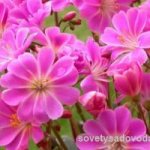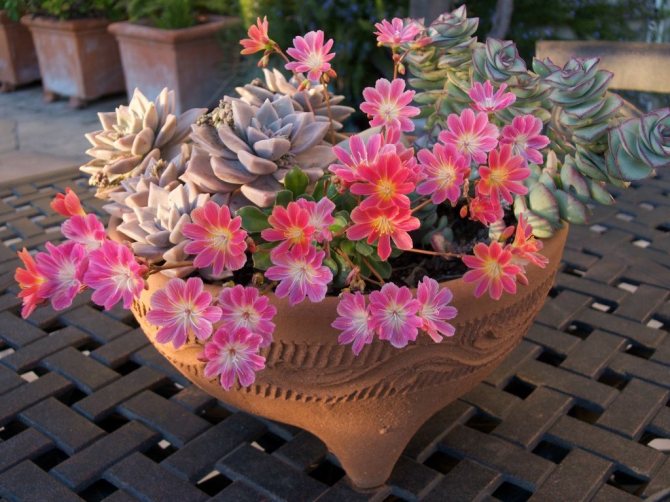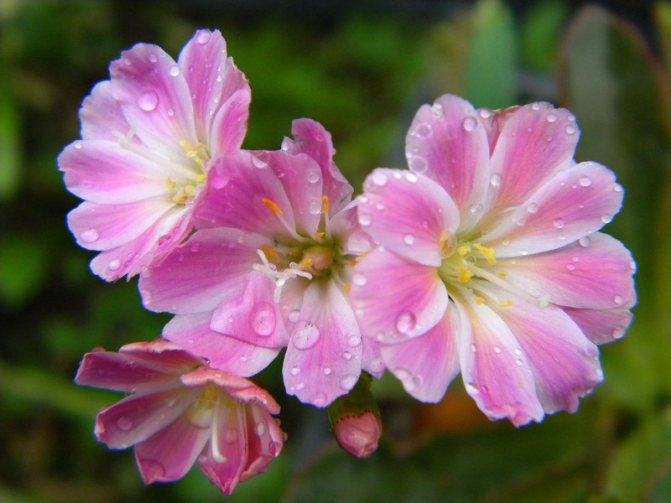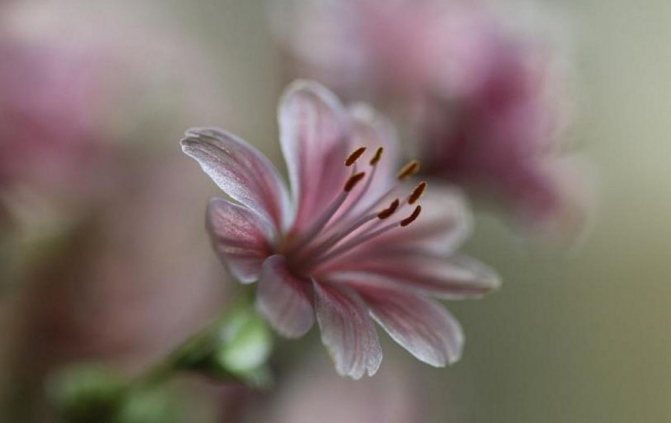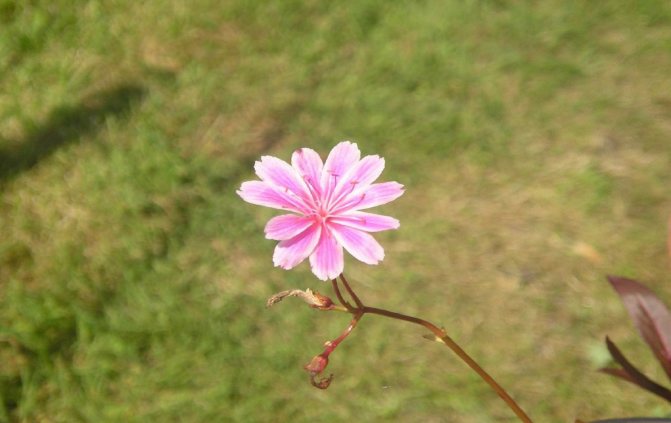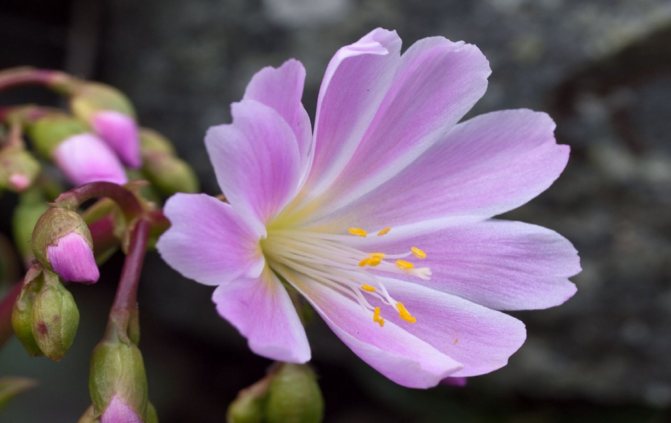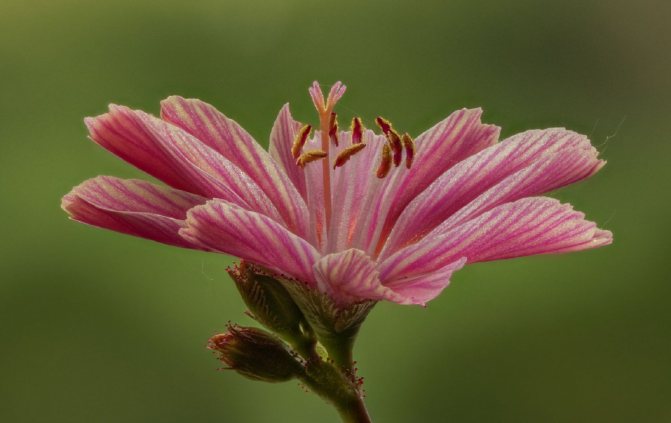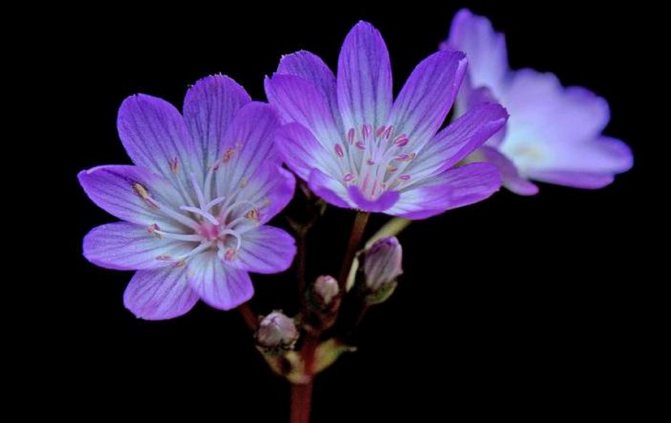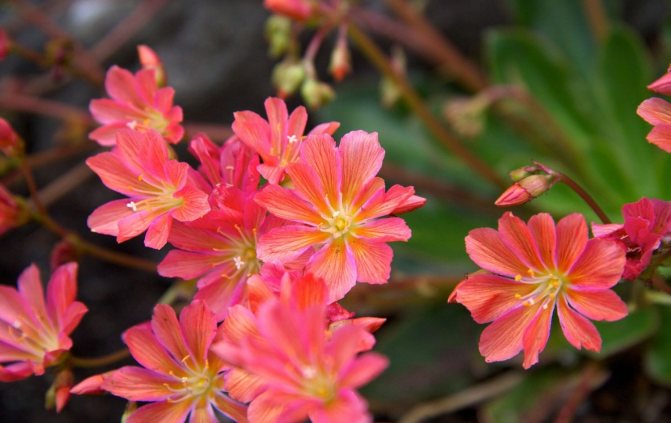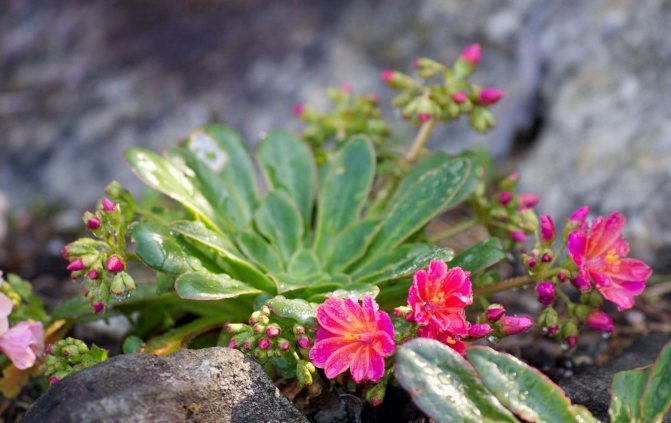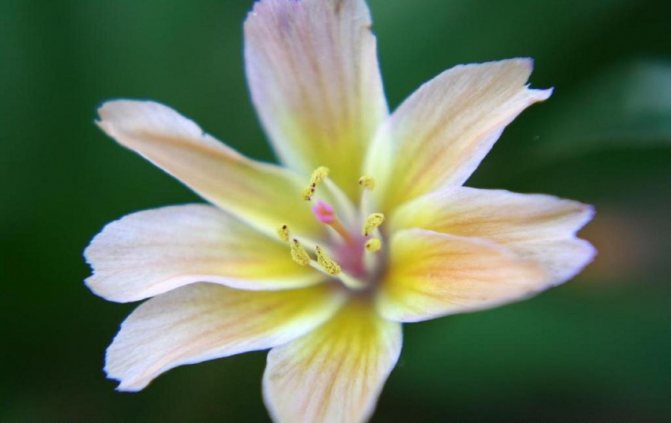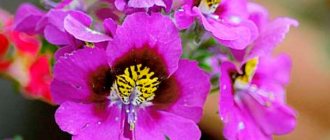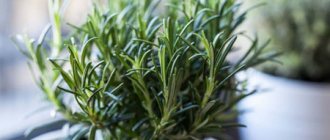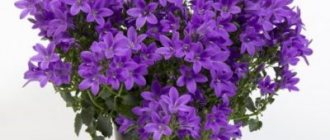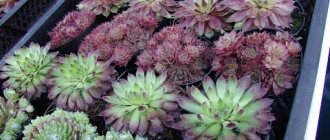Welcome friends on the site advice to gardeners. Levisia is an evergreen perennial plant of the purslane family. Today we know about the existence of twenty of its species.
Previously, this plant could be found in the mountainous regions of North America. It usually grows about three meters above sea level and reaches almost thirty centimeters in height. It has very juicy, well-colored, wavy, evergreen leaves, collected in a rosette.
Levisia
The Levisia flower is a peduncle, up to twenty centimeters high, from many buds that create the appearance of a gorgeous bouquet. Levisia has three stages of flowering, it begins in April and can last until autumn, until September, that is, it blooms throughout the summer season.
The color of the flowers is quite varied. Available in salmon, white, pink, striped red, yellow and pastel. The diameter of the buds is four to five centimeters.
When the plant is not yet blooming, it is somewhat similar to succulents. Levisia is a very beautiful flower and requires a special approach to itself, therefore, the cultivation of Levisia is a rather laborious work, and is subject only to gardeners with extensive experience.
Description of levisia
Levisia is a perennial evergreen succulent that belongs to the Montiev family. These charming flowers can surprise even seasoned flower growers. Flowering is a spherical inflorescence, consisting of many brightly colored flowers - a real bouquet. They can be painted in white, pink, red, yellow, lilac, purple and other shades. The diameter of the corolla reaches 5 cm, the length of the petals is 2 cm, and the width is 5 mm.
The core consists of a pistil surrounded by a dozen filamentous stamens. The petals have pointed or ragged edges. Delicate silky flowers bloom in April and delight until the end of September. The bush is modest in size - 10-35 cm high. Smooth fleshy leaves form a dense basal rosette. The stems are thin, the flower stem is 20 cm long and rises above the bush.
In the natural environment, the Levisia prefer the highlands of North America - arid and rocky places. Strong roots of Levisia, consisting of small nodules, go deep into the soil in search of moisture.
2. Varieties:
2.1.Lewisia Constellation or obtuse-leaved - Lewisia cotyledon
Compact, herbaceous, flowering, evergreen perennial plants of incredible beauty. The leaves are thick, juicy, oblong, collected in basal rosettes. The leaf blades are glossy, entire, green. Peduncles are leafless, strong, and bear funnel-shaped flowers up to 2.5 cm in diameter at the tops. Leaves reach a length of 18 cm. Each leaf rosette is capable of producing several peduncles. Flower shades range from white to yellow, pink, salmon, orange, lilac, red and purple. Plants bloom in late spring - early summer.
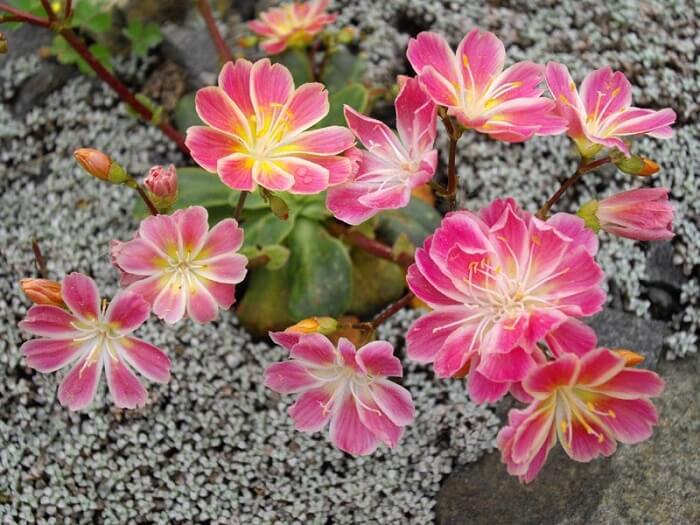
2.2 Long-petaled levis - Lewisia longipetala
Attractive, evergreen, compact, herbaceous plants forming a rosette of long, green, belt-like leaves reaching 7-15 cm in length.Each plant can form many erect peduncles, at the top of which are relatively large - up to 4 cm in diameter, attractive flowers. The flower petals can be colored cream, white, yellow, orange, salmon, pink or lilac.
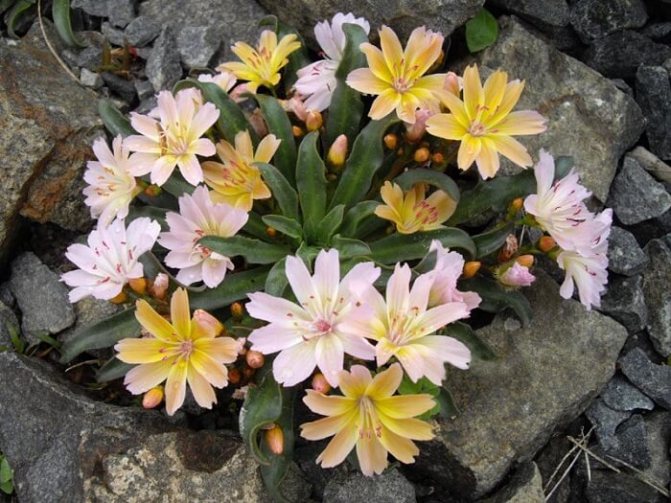

2.3. Nevada levision - Lewisia nevadensis
Green, attractive, herbaceous perennials, forming a rosette of green, belt-like, thick, succulent leaves up to 13 cm long. The leaf blades sometimes have a bluish waxy coating. Low erect peduncles bear loose inflorescences on the apical inflorescences with bright, pastel-colored flowers up to 4 cm in diameter. Flower petals can have greenish, white, pale pink or light lilac shades.
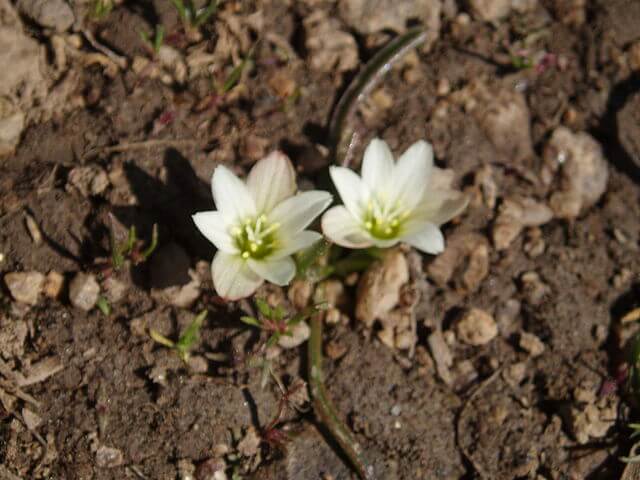

2.4 Levision of the pygmies - Lewisia pygmeae
Miniature flowering, evergreen perennial with long, very thick, almost rounded in cross section, green leaves. The leaf blades are only 2 to 8 cm long. Peduncles are very short - the buds are almost at the base of the leaves. The flowers are bright, attractive, painted in white, lilac or pink shades. Plant height often does not exceed 4 cm.
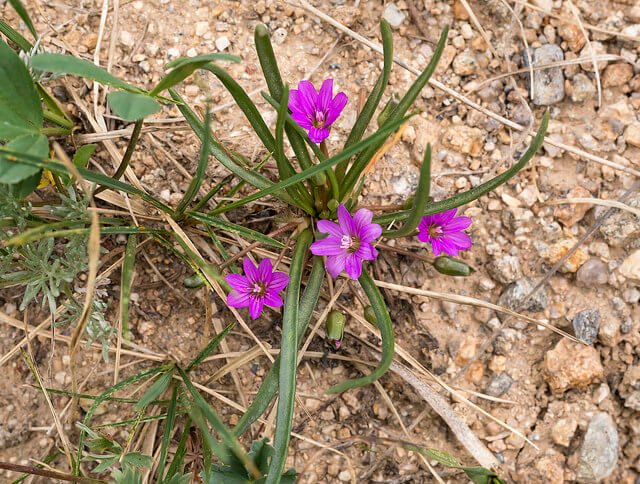

You may also be interested in:
Growing levisia from seeds
Sowing in the ground
In the second half of October, you can sow before winter. Choose a shady location without direct sunlight. The western and eastern slopes of the alpine slide are ideal. An acidic, rocky or sandy, well-drained soil is required. Bring humus under digging: 1 bucket per 1 sq. M. The seeding depth is about 0.5-1 cm. Mulch the crops with a thin layer of dry peat. Seedlings will appear in April, but expect flowering in the second or third year.
Growing seedlings at home
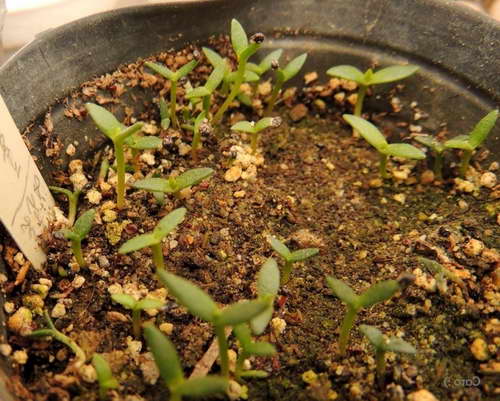

Levisia from seeds photo of seedlings
Start sowing seedlings in early March. Prepare a sand-compost mixture in a ratio of 1 to 2. For disinfection, scald with boiling water or hold in a water bath. Place the hot substrate immediately in a shallow plastic dish with drainage holes. Without waiting for the soil to cool, sow the seeds: spread them over the soil surface and cover with a thin layer of soil mixture (up to 3 mm thick).
Cover the seed container with a transparent plastic bag. It is necessary to recreate the natural mountain conditions conducive to the successful germination of seeds. For this, for the first 10 days, it is necessary to keep the crops warm at room temperature. Then place it in a cool room for 10 days (you can place it on the lower shelf of the refrigerator), maintain the temperature from 0 to + 4 ° C. Then return to warm again.
After stratification, check the greenhouse for seedlings daily. Usually the seeds hatch after 2-3 days after returning to heat. With the emergence of seedlings, it is necessary to provide bright lighting, preferably artificial.
After another 10 days, the seedlings dive and sit in separate cups. If there are no germinated seeds left, re-stratify. It is recommended to pour calcined river sand under the saplings that have been cut open. Water with warm water (approx. + 25 ° C). On the 10-12th day after the pick, add a weak solution of complex mineral fertilizers.
By the end of spring, you can plant the bushes in open ground. It is recommended to lay out the soil under the leaf rosettes with river pebbles or fine gravel to protect the lower leaves from getting wet, and the root collar from decay. Expect flowering next year.
Reproduction
Succulent propagates with the help of seeds and dividing rosettes in June. The procedure is carried out only if the peduncles were removed in the spring in order for the rosette to grow. Cut it down along the horse. Delenki take root for several weeks.
Growing Levisia from seeds. Seeds are stratified before sowing.They are sown to a depth of 3 mm in a wet peat-sand mixture and kept for 2-3 weeks at a temperature of 0-5 ̊С, placed in a refrigerator. After germination, which usually takes about 3 weeks, the container with the seedlings is placed in a warm place with diffused light. The soil is periodically sprayed with water. After the appearance of the first two or three leaves, the succulent is dived and in the spring the grown seedlings are planted in open ground.
In landscape design, crops such as sedum, asperula, alissum, purslane, rejuvenated, fescue and other cereals, winged grass, and kolnik are ideal plant companions.
How to care for a Livision
Watering
Moderate watering is required. Stagnation of moisture at the roots is detrimental to the plant. When watering, apply water strictly to the root, avoid getting moisture in the center of the leaf outlet and on the flowers. If the weather is rainy for a long time, it is advisable to cover the bushes with halves of plastic bottles.
Top dressing
Don't overdo it. An excess of nutrients negatively affects the condition of the plant. It is enough to apply fertilizers every 3-4 weeks. Alternate mineral and organic supplements.
Reproduction
Mature plants form daughter rosettes that can be used for propagation. To do this, the baby is carefully cut off from the mother bush, the cut is treated with crushed coal and planted in a light, poorly nutritious soil. Before rooting, the rosettes are kept cool under diffused light. When the children grow a "brush" of their own roots, you can start planting in open ground.
Wintering
In mid-latitudes, the plant overwinters successfully under a thick layer of fallen leaves. To protect the bushes of evergreen Levisia from melt water, they are covered with glass jars for the winter. Deciduous varieties do not require such shelter.
Use in landscape design
When planting in open ground, levisia is used to create;
- flower arrangements;
- rock garden;
- rockery;
- as a ground cover plant.
This flower with bright buds seems to be created for the decoration of alpine slides. Levisia feels great on stony soil, harmoniously combined with dark green low plants, large stones and snags. Huge buds, especially in comparison with the rather small leaves of a dark green hue, can be used for the borders of the club.
A low-growing plant will look good on the front edge so that taller neighbors do not create unnecessary shadow and do not obstruct the beautiful Levisia.
Diseases and pests
Gray rot poses the greatest danger to Levisia. Fungal infection appears as orange-gray spots on the leaves. If a problem is detected in time, the plant can be saved. It is necessary to remove the affected leaves and treat with a fungicide. At advanced stages, the plant will have to be destroyed.
Slugs and aphids are the main pests of levisia. Slugs are disposed of mechanically, traps and chemicals.
Treatment with soapy water or garlic infusion will help to overcome aphids. In extreme cases, use insecticide treatments.
Possible difficulties and typical mistakes
The main challenge in cultivating this vibrant flower is to always maintain optimum soil acidity. Therefore, many people prefer to plant it in large pots, and then decorate alpenhouses or other flower arrangements right with them.
Without good drainage, this plant dies, since the lower leaves are close to the surface of the soil, the stem is practically absent. Constant contact with moist soil leads to rotting first of the lower part of the plant, then the whole flower. To prevent the leaves from touching the ground, it is recommended to prop them up from below with small stones.
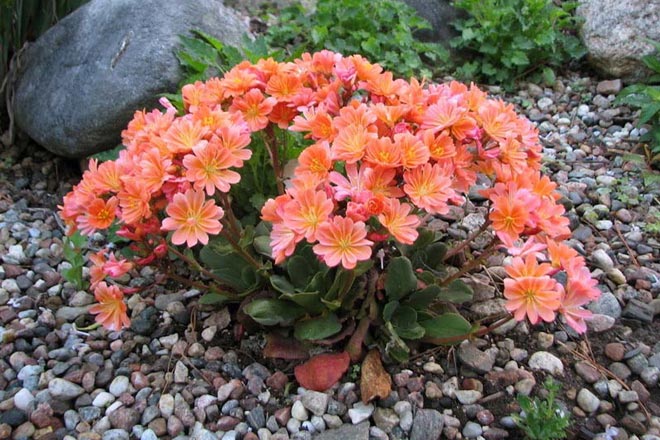

For the rest, the flower is hardy, pleases with bright rich flowering, rarely suffers from diseases, tolerates various types of dressings well, including organic matter.
Types of levisia with photos and names
There are about 20 types of levisia, many of which are cultivated. Let's consider the most popular ones.
Levisia Blunt or Cotyledon Lewisia cotyledon
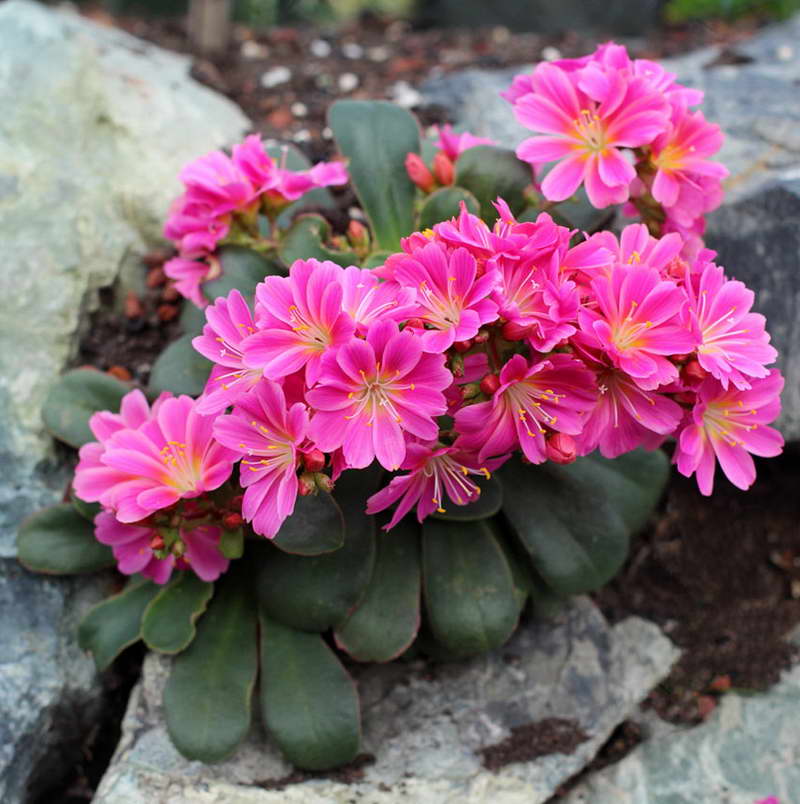

Levisia Blunt or Cotyledon Lewisia cotyledon Magenta
It has long, rounded leaves with wavy edges. During the flowering period, 8-15 peduncles with pink buds appear. 3-4 flowers are simultaneously revealed on one peduncle. Varieties differ in color of flowers:
- Alba - snow-white flowers;
- Comets - all shades of yellow;
- SunsetStrain - sunny yellows and oranges
- Constellation - pink-orange petals with a light border;
- Red - red;
- Rose Splendor - hot pink.
How levisia reproduces
Flower reproduction is possible both vegetatively and by seed. They are equally uncomplicated, so they can be used even by a novice florist.
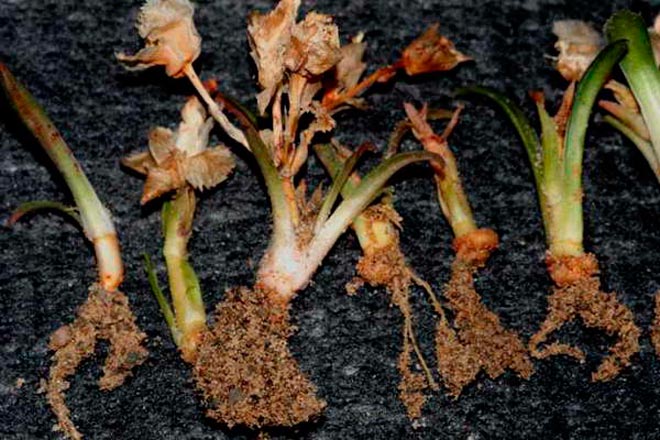

Cuttings
Cuttings (lateral shoots without roots) are removed in spring, placed in loose soil in small pots. Before that, the cutting can be treated with a fungicide in order to prevent fungal diseases and a growth stimulant. Planting material must be kept in a cool room, and as soon as roots appear, dive into the garden bed.
Seeds
Growing from seeds must be done quickly, since they instantly lose their germination. The procedure is performed in November, the beds are prepared in advance. Seeds placed in the ground should be sprinkled with compost or peat. The first shoots should be expected no earlier than April.
Then they are either immediately dived, or left for one year in the garden, and only then are they transplanted to a permanent place.
The best varieties of Levisia with photos and names
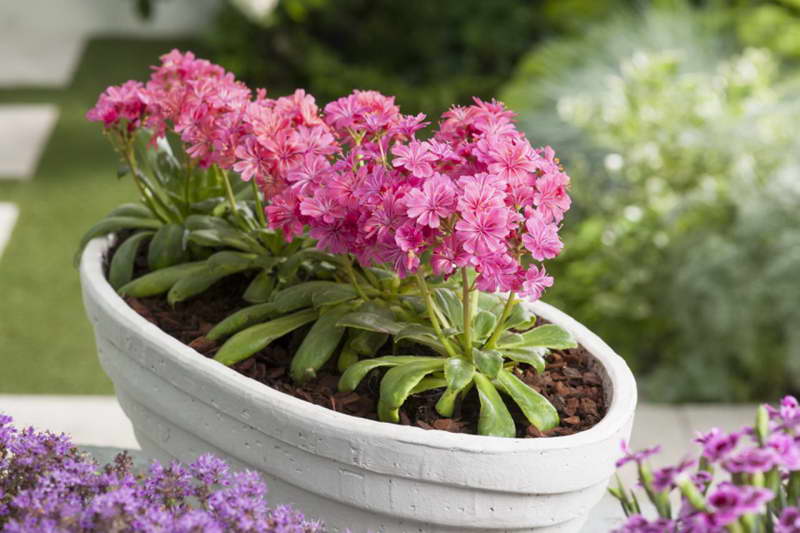

Lewisia Elise Ruby Red photo
Low compact bushes of the Alice Ruby Red variety have fleshy leaves with a slight waxy sheen, paniculate inflorescences are densely covered with pink flowers. The variety is most commonly grown as a container plant.
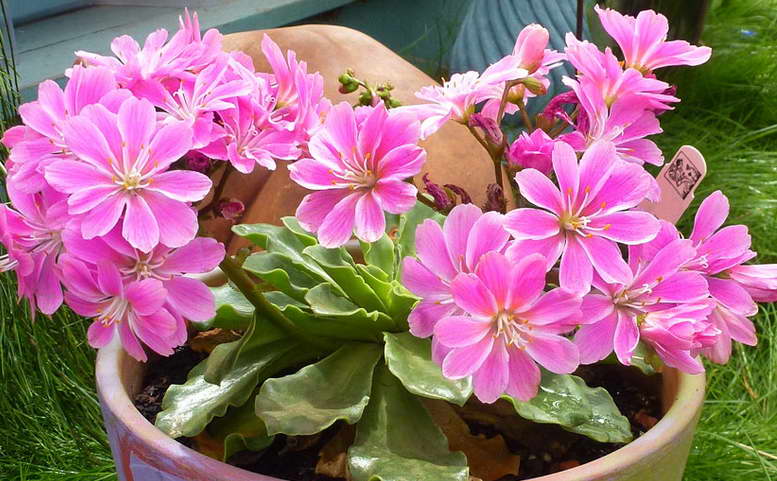

Levisia pink shadows photo
Long petals of bright pink flowers are bordered by an almost white narrow strip of milky shade along the edge. Paniculate inflorescences are densely covered with flowers, a powerful root rosette of leaves is slightly raised above the ground.
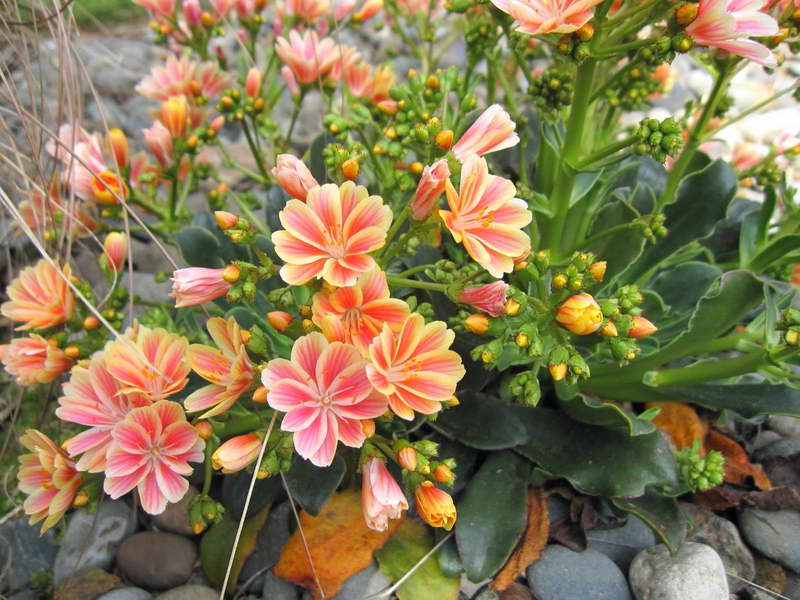

Levisia constellation photo
Very beautiful variety with coral flowers Constellation. Good for both rockeries and container growing.
The discovery of Levisia came about thanks to Captain Meriwether Lewis during his expedition to cross America from the Atlantic to the Pacific Ocean. In this article, we will consider what kind of plant it is, its varieties and cultivation features.
Species and varietal diversity of Levisia
The genus Lewisia combines more than 20 species of these miniature but delightfully colorful plants. In the modern appearance, Levisia is practically not found in nature: in the garden culture, various hybrids are mainly used, the flowering of which, in terms of massiveness and beauty, is also pulled with rhododendrons.
But the main division of Levisia concerns the type of foliage. Among these plants are:
- evergreen species and varieties;
- deciduous species and varieties.
They require a slightly different approach to cultivation, because specimens with winter-green foliage are much more capricious, especially in terms of the wintering parameter.
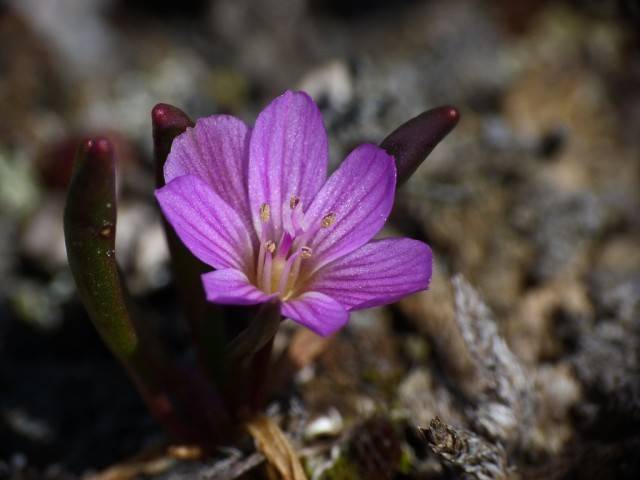

Dwarf levisia (Lewisia pygmaea).
When choosing levisia for your garden, first of all focus not on the assortment of species plants, but evaluate the assortment of hybrids available to you. Usually, it is the hybrid Levisia that blooms most effectively and colorfully, and it is easier to grow them. Focus on color, not name, and habitual growing conditions. Here are just a few of the most common hybrid varieties:
- "Magic of Fuchsia" with a dazzling bright color of a rich pink-purple color;
- pale pink levisia "Pinky", perfectly tolerating dampness;
- pearl-white abundantly colored Levisia "Pearl of Ash";
- a snow-white variety with flowering Roy Elliott lasting almost 3 months;
- orange, dazzlingly bright variety with a large leaf rosette "Matthew";
- bright orange "Sunset Strain";
- "Norma Jin" variety, which forms dozens of rosettes and hundreds of flowers, with a pastel pink color;
- "George Henley" with the brightest shade of fuchsia flowers, under which the rosette is not visible;
- Levisia "Trevosia", uniquely looking in terracotta pots, with its sunny, melon-apricot color.
Most hybrids begin to bloom in May, and it lasts at least until August, and most often continues even in September.
But even out of 20 species of Levisia, a larger number of plants are over-decorative.
The easiest to grow and the most affordable and widespread species of the Levisia - levisia cotyledon (lewisia cotyledon) and various hybrids based on it. This is an evergreen perennial with very long, up to 15 cm smooth leaves with an unusual red border along the wavy edge. In different conditions, this levisia forms rosettes of leaves that are excellent in shape and density. But the bright bloom remains unchanged. In May and June, Levisia cotyledon produces lush inflorescences of flowers with 6-15 petals in each.
Colors vary, mutate with seed and can represent variegated orange, red, pink, yellow combinations, or white with dark stripes and broad streaks of contrasting color. The plant, unique in its brightness, seems to be hand-painted. Of all the cultural forms of cotyledon, the snow-white "Alba" has earned the greatest popularity.
Noteworthy and levisia long-petaled (lewisia longipetala), which blooms from June to July. a beautiful rosette of long, belt-like leaves serves as an excellent background for slender petioles up to 10 cm long and four-centimeter flowers resembling tiny water lilies both in shape and pink in color.
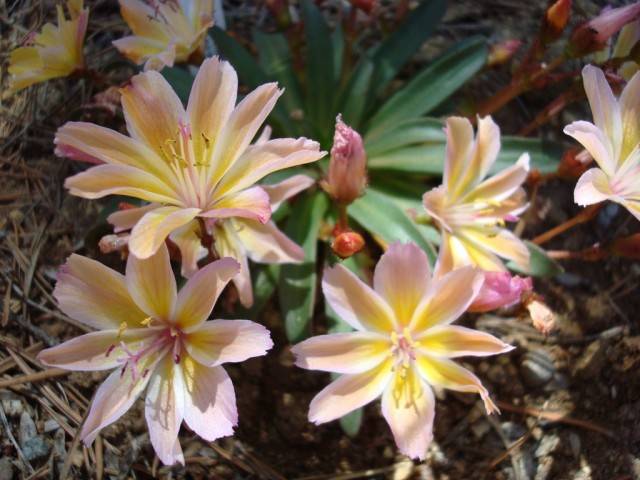

Levisia long-petaled ‘Little Peach’ (Lewisia longipetala). <>
Levisia short-peel (lewisia brachycalyx) is a beautiful and very delicate Arizona species with a deciduous crown, long, up to 10 cm leaves, covered with a bluish bloom. This levisia blooms all spring, and the crown is actively growing in the fall after a short summer dormant period. The color of the flowers is watercolor, with a delicate pink at the tips of the petals and white in the center, although it can vary within the white-pink range depending on growing conditions.
Colombian levisia (lewisia columbiana) is an evergreen species with a compact rosette of tongue-shaped leaves and a tall thin peduncle crowned with white-pink flowers with bright veins. This Levisia has a wonderful variety of Rosea with fuchsia, bright pink flowers and half the size. Colombian Levisia blooms from May to August.
For large, wide and very fleshy leaves Levisia Tweedy (lewisia tweedyi) has earned the nickname "flowering cabbage" for a reason. Bright green or purple, these beauties adorn rocky gardens with extremely attractive rosettes of leaves, against which the bizarre flowers seem even more touching.
Reaching 5 cm in diameter, the flowers of this revision are painted almost exclusively in fruit shades - melon, orange, apricot with the obligatory watercolor blur along the edge of the petals. At the same time, the color varies and changes, often hybridizes. This type is considered one of the most catchy and spectacular levisia. For the winter, it is better to dig up Levisia Tweedy and transfer it to greenhouses, because it does not tolerate winter dampness.
Levisia sierra (lewisia sierrata) is an evergreen species with very beautiful serrated grayish leaves and surprisingly large five-petal flowers for such thin peduncles. On them, against the background of the basic pale white-pink color, contrasting dark pink veins stand out brightly.Beauties bloom with flowers somewhat reminiscent of a lily from May to July.
The size of the plant itself will not exceed 6 cm, and the flowers are just over a centimeter. But this miniature miracle can charm anyone against the backdrop of rock. Outwardly, the rarer levisia cantelovii looks like it, in which the shoots grow up to 30 cm and the rosettes are formed by more serrated leaves.
Unusual levisia nevada (lewisia nevadensis) the eye would seem to be a relative of the daisy, if not for its thick, fleshy leaves with a deformed, curved shape. Snow-white flowers with green-yellow stamens bloom only on sunny days, but flowering lasts from May to the end of August. This is an unusual, seemingly fresh plant that can quickly and actively spread by children.
Levisia dwarf (lewisia pygmaea) is a real dwarf succulent that releases in late spring long, 10 cm leaves from the underground root, creating a very peculiar and seemingly buried rosette. Umbrella inflorescences of 7 white or pink flowers up to 2.5 cm in diameter seem weightless, touching, droop beautifully, and sometimes lie on the ground. In the summer, this Levisia hides. And with the arrival of autumn, the rosette begins to grow leaves again.
Rare and very valuable Levisia Congdon (lewisia congdonii) - a species with high flowering shoots and a powerful rosette of leaves. Reaching a height of 60 cm, it is crowned with inflorescences of pastel, pale pink flowers with classic touching dark veins. This Levisia blooms from mid-spring to late June. But it can bloom again in the fall.
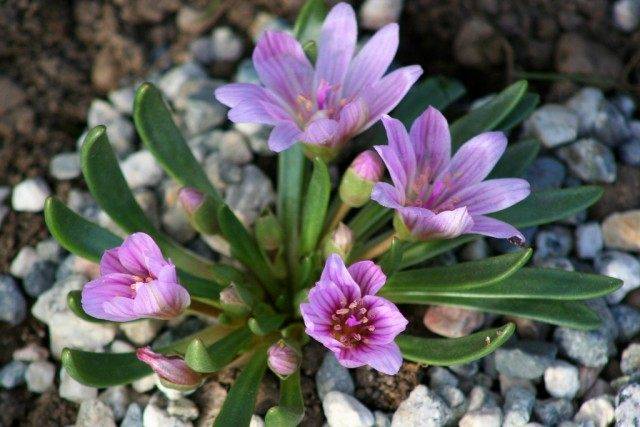

Levisia nevadensis (Lewisia nevadensis). <>
Also, it is extremely rare and:
- levizia two-peel (lewisia disepala), in which leaves in a rosette up to 5 cm in diameter disappear during flowering, and pale pink flowers appear to be luminous and reach 2-3 cm in diameter;
- Levisia Kellogg (lewisia kelloggii), also dying off after a lily-like snow-white flowering in July and waking up again in autumn;
- levisia lee (lewisia leeana) with very thick, cylindrical in section leaves and inflorescences collected in panicles up to 20 cm high;
- Levisia Maguire (lewisia maguirei) with short leaves and snow-white flowers in complex umbrellas;
- blooming only when the soil remains moist in spring after the snow melts (March-May) levisia opposite-leaved (lewisia oppositifolia) with a loose inflorescence of 5 white flowers and flexible shoots, as well as its dwarf form "Richie";
- renewed levisia (lewisia rediviva) with luxurious 5-7 cm flowers, offering to admire all shades of the pink spectrum from almost white to the most intense. Her flowers bloom over the rosette of leaves only on sunny days (she is very moody about humidity in winter);
- able to bloom only 5 years after sowing Levisia Stebbins (lewisia stebbinsii) with shoots spreading around a tiny leaf rosette and touching watercolor pink flowers with a beautiful center.
In ornamental gardening and floriculture, Levisia is used:
- as an exquisite accent for an alpine slide, decoration of the eastern and western slopes;
- for "piece" accents in rockery;
- as the finishing touch of the design of compositions with sprinkling the soil with stony crumbs;
- in the role of an elegant, festive pot culture, for portable rock gardens;
- as a touching touch or accent in the design of front gardens, "ceremonial" flower beds or mixborders.
Levisia can be grown:
- as a perennial for open ground;
- as a potted plant, which is removed indoors for the winter, and grown as a garden culture in the open air during the warm season (or used to decorate a balcony).
Botanical description
Levisia (Lewisia) is a dwarf, perennial plant, belongs to the Montiev family. The genus has about 20 species. The root system is branched or fusiform, less often spherical. The stems are simple or branched. Basal or stem leaves, in rosettes. Inflorescences are racemose, paniculate or cymoid.
The flowers consist of 5-10 petals. Colors range from white to all shades of pink, to crimson and yellow, to orange in cultivated forms. The fruits are boxes.Most of the species are deciduous, some are evergreen.
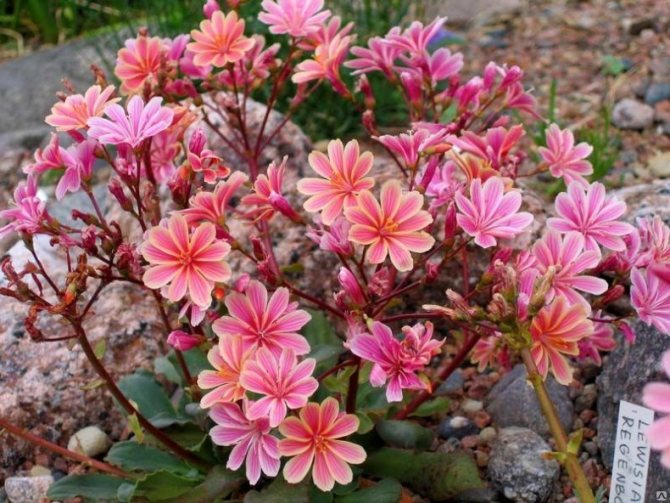

Lush bloom of a real aristocrat Levisia
A unique perennial with luxurious flowering - endemic to North America. At the same time, Levisia cannot be found in nature on any continent. All levisia develop quite specifically, the plants depend on humidity in the summer and can completely disappear and then reappear imperceptibly.
Most levisiae actively develop from spring to flowering, which begins in May-June and lasts until July-August, after which the foliage dies off. But there are also species in which foliage develops in autumn, and flowering occurs in early spring, and crops that keep leaves with comfortable humidity.
In height, Levisia will not exceed 30 cm and in most cases is inferior in size even to low-growing azaleas. The plant develops in the form of a rosette of elongated leaves and with a beautiful bluish edge, which can be whole lingual, lanceolate, and beautiful toothed. Thick and leathery, they blend beautifully with stone chips and the texture of large boulders.
The main feature of Levisia, which turns the plant into a truly unique garden species, is a luxurious flowering. It is not just decorative, but incomparable in its aesthetic characteristics. Complex inflorescences with a bright yellow center and rounded or elongated "petals" are more reminiscent of chamomile, then luxurious lilies or magnolias.
Levisia flowers reach 5 cm in diameter, which, given only 5-6 times the size of the bush, makes them seem even more huge. Of course, there are also Levisia flowers that are much more modest in size, but even centimeter-long flowers of tiny species against the background of bushes seem large and shining.
The beauty of the bloom seems to be even greater due to the duration. After all, Levisia blooms tirelessly throughout literally the entire summer. How such a crumb can bloom tirelessly remains a mystery. True, the answer to it is very simple: Levisia will arrange a three-month show only with proper care, which should provide the plant with the necessary nutrients in large quantities.
The Levisia color scheme includes various variations of bright shades of pink and orange, as well as rich tones of the white and yellow spectrum. At the same time, color variations can not be called anything other than watercolor: sometimes bright and daring, then gentle and pastel, salmon, fuchsia, apricot and other tones that always look advantageous conquer with freshness and purity.
Most Levisias have complex colors, with darker spots and veins. And the difference in color saturation between the buds that have just blossomed and already mature flowers makes the colorful decoration even more elegant.
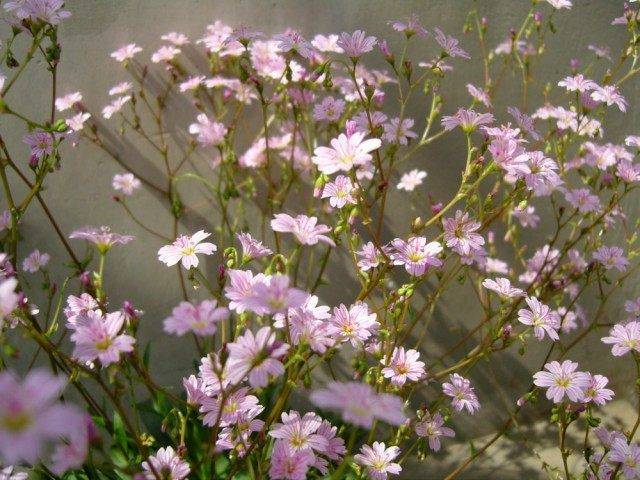

Lewisia congdonii
Popular varieties of Levisia
The most popular varieties are:
- levisia cotyledon (blunt-leaved) - the most common type, has several flowers on thick stems and wavy oar-shaped leaves. It is an evergreen perennial with juicy, fleshy leaves. The diameter of the rosette reaches 10 cm and the height of the peduncle is 20 cm. The color of the petals in hybrids varies from white and yellow to bright pink and red. The soil prefers drained, acidic, fertilized with fresh manure. It should be planted in shaded areas, does not tolerate excess moisture;
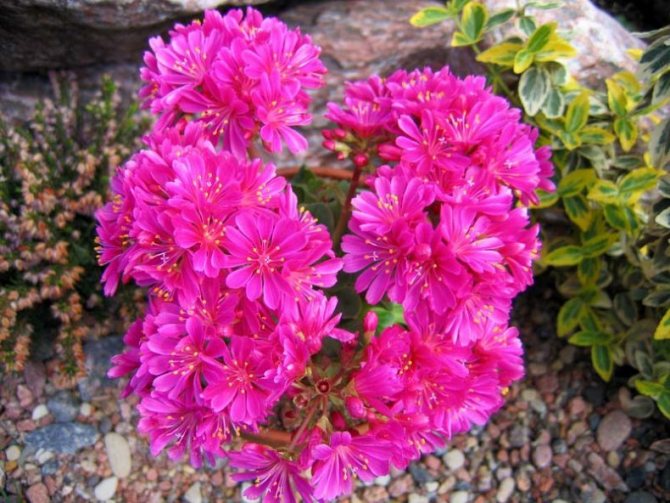

- levizia two-peel in nature, it is found only near the snowy peaks in Yosemite National Park, California. This species is notable for its small stature, barely reaching 5 cm in size. The flowers are pale pink in color, and flowering continues from February to June. A very difficult species to cultivate;
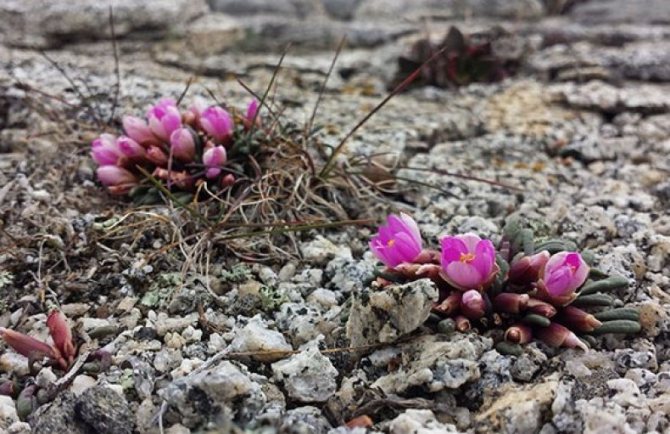

- Levisia Tweedy has numerous white or pale pink flowers, thickened leaves. Grows up to 10 cm, loves dry and sunny places. Prefers acidic soil. Not easy to cultivate. Flowering lasts from April to June;
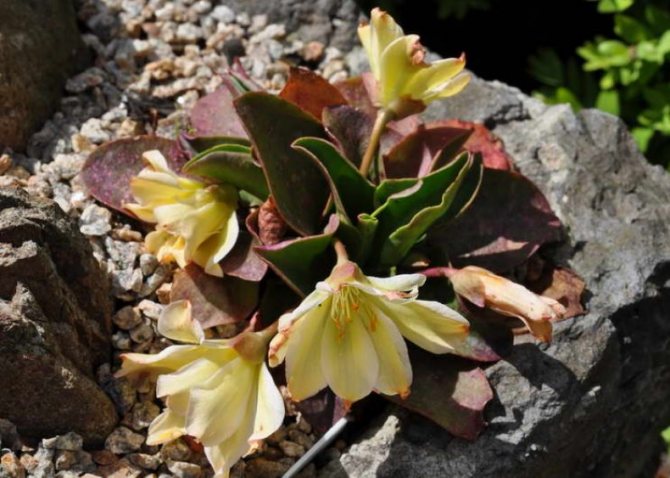

- Levisia Congdon prefers wet conditions. Grows in the peat bogs of Nevada. It grows up to 20 cm. It has ash-pink flowers with small veins. Grown only by collectors, as it is very demanding to care for;
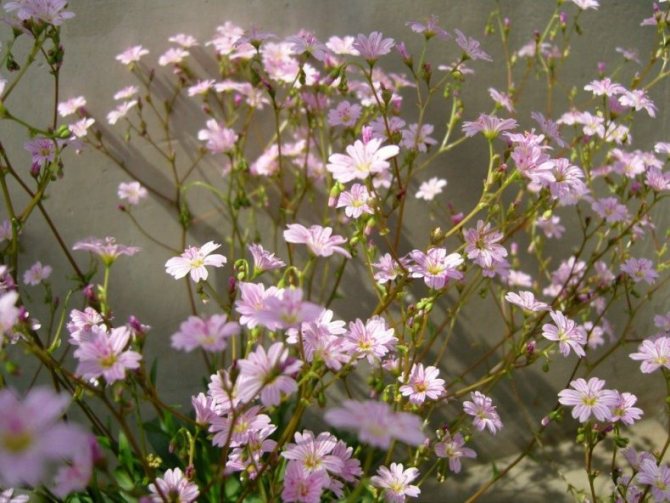

- dwarf levisia takes first place in endurance, but clearly loses to its relatives in brilliance. It has thin, tongue-like leaves that die off by the end of summer. The size of the flowers barely reaches one and a half centimeters. It propagates easily by seeds and is not whimsical at all.
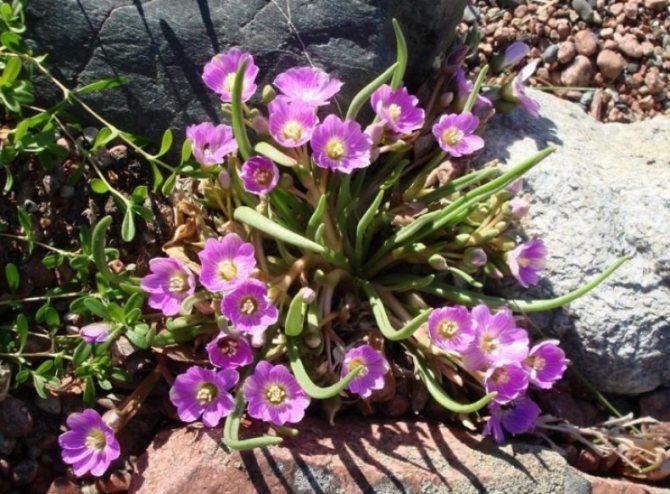

Types and varieties
Levisia Tweedy. (L. tweedyi). Flowers of pastel colors with a diameter of 5 cm bloom in May. The height of the bush is only 15-20 cm. The leaves often have a spectacular purple hue. Feels comfortable in partial shade between stones. Cultivation of this species of Levisia is quite problematic, therefore it is recommended for cultivation only for experienced gardeners. The key to success is constant moderate humidity during the summer and some moisture during the fall and winter.
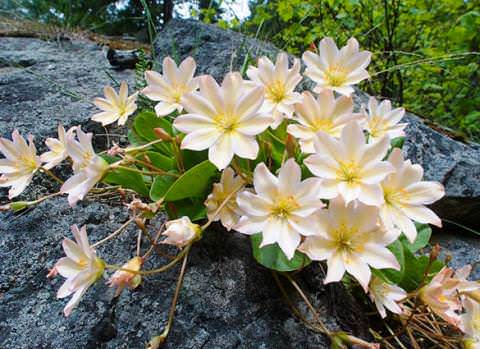

Columbian levisia (L. Columbiana). It is characterized by long, thin peduncles that bend sideways under the weight of numerous white flowers. Flowering begins in May and continues in June.
Levisia Nevada (L. nevadensis). Refers to deciduous and unpretentious species. Blooms in May. Under unfavorable conditions, during drought and intense heat, the succulent passes into a forced state of dormancy, the ground part ceases to develop and dries up. Produces abundant self-seeding, which can displace small neighboring crops. Seedlings bloom in the second year. Does not require protection from excess moisture throughout the year.
The group of miniature deciduous species L. rediviva is characterized by the fact that the leaves dry up with the growth of peduncles, and huge bright single flowers open in May.
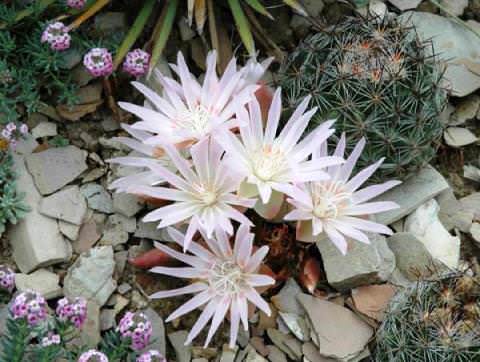

If you understand the needs of the plant, then caring for this species of Levisia will not be difficult. Rediviva grows in areas with minimal rainfall from May to September, so in rainy climates it is better to grow it under cover. Watering is carried out only in the spring.
Levisia cotyledon (Lewisia cotyledon). It is the most widely cultivated species, which strikes with a variety of varietal forms. The leaves form a wide rosette, sometimes up to 40 cm in diameter. Pink, red, yellow, white and orange, depending on the variety, flowers appear on numerous peduncles in May and bloom gradually, turning the succulent into a bright and lush floral bouquet.
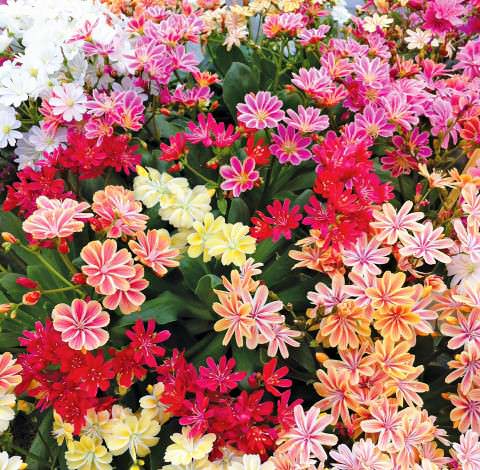

Sort "Elise Mixed"
If you find a place in the garden where the root collar of the plant stays dry throughout the winter, then the colorful succulent plant will delight you for years to come. In principle, this condition applies to almost all types of culture.
Dwarf levisia (L. Pygmaea) is a group of the shortest deciduous representatives of the genus, which are distinguished by their unpretentious care. Flowering occurs in the spring, and in the summer the leaves dry up so that they can start growing again during the autumn rains.
Varieties and hybrids of the above-mentioned Levizia species are cultivated in the gardens. Constellation is one of the most popular varieties that can often be found on sale. Stunning beauty of the Lewisia cotyledon varieties: Sunset Strain, Elise Mixed, Mountain dreams, Regenbogen.
Growing and caring for a plant
Levisia is a rather peculiar flower. In order for it to please you with its flowering, it is necessary to study the features of its cultivation.
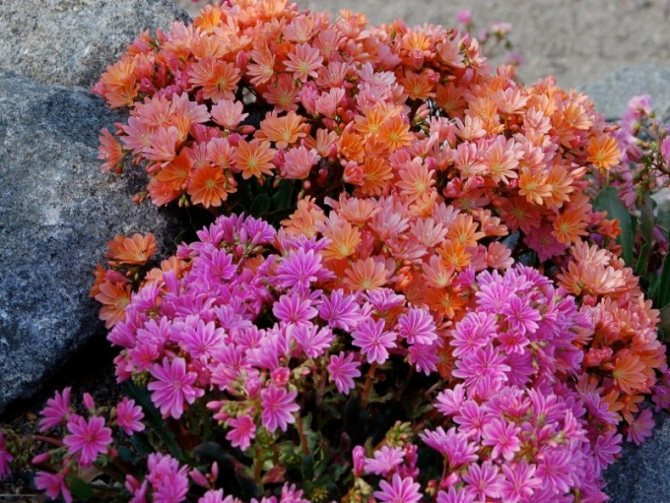

Conditions of detention
This flower can be grown both outdoors and in pots. The cultivation method depends on the selected species. As indicated above, Levisia does not tolerate direct sunlight, so planting should be done on the eastern side of the garden.
When growing in pots, replanting should be done in spring and autumn. In the summer, it is advisable to take out the flower pots to fresh air, and in the winter to keep in a cool place.
Soil and fertilizers
Levisia prefers acidic or slightly acidic, well-drained, loose soil with an admixture of peat, sand, limestone. Despite all this, the soil must remain nutritious. Crushed cow dung is used for fertilization.
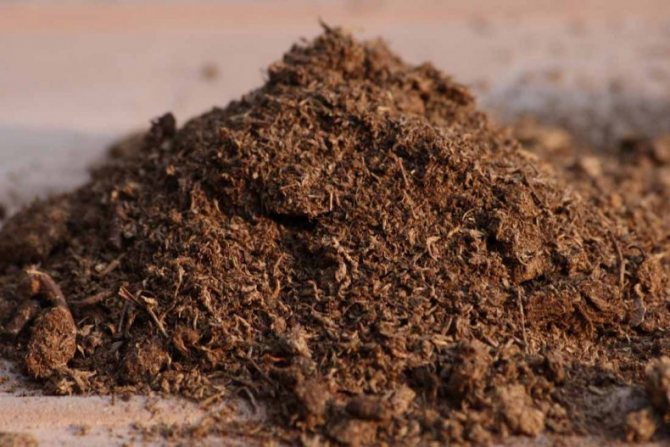

Where is it better to plant Levisia
This plant will love planting in a semi-shaded location, away from direct sunlight. Best between decorative stones of an alpine hill or over a wall or curb, best on the west or east side.
Moreover, it is necessary to plant a plant by tilting it a little. She really does not like stagnant water, and may even die, and in this case the water will not stagnate.
The plant has long, strong roots, like laces, which are able to extract nutrients from the depths of their own accord. To prevent the plant from rotting from stagnant water, cover it with a layer of gravel or sand.
A suitable soil for a cultivated plant is acidic, fertile, well-drained, preferably with the addition of gravel or coarse sand.
Benefits of "grassy magnolia"
Seeing these beautiful flowers, you will not immediately guess that this is a succulent.
This compact perennial came to us from North America. It grows to a maximum of 30 cm. Of course, at home, he manages to cling to rocky slopes at an altitude of about 800 meters above sea level!
The root of the plant is strong, deep; due to the presence of small nodules in which the plant stores water and nutrients, levizia can survive even in gravelly soil.
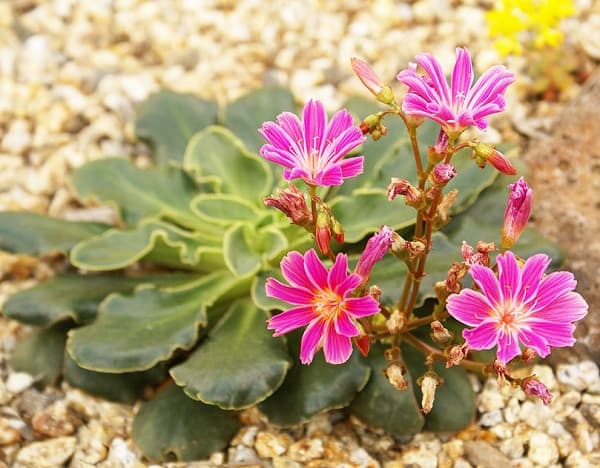

But at the same time, the plant is a little capricious. The fact is that Levisia is very fond of warmth and light, but without brute force; cannot live without water, but is afraid of overflow.
Flowers the plants are a bit like magnolia, only a few times smaller in size. You can admire the flowering of Levisia from April / May to September. And when there are no flowers, the bushes are decorated with green flattened leaves, collected in a rounded basal rosette.
Origin and description of the plant
The Levisia plant is native to North America, it is impossible to meet it in the wild growing on any other continent. Development takes place in a specific way - the color and size of the flowers, even the appearance itself completely depends on the humidity in the summer. It grows more often at an altitude of 4 km. There are over 20 types. The plant belongs to the purslane family.
Flower description:
- the height does not exceed 30 cm, therefore, when creating flower arrangements, it is used in the foreground;
- consists of a rosette with oval-shaped leaves and a lush edge at the top of the shoots;
- flowers can be lanceolate, serrated or tongue-shaped, leaves are leathery, thick, often dark green;
- the roots are small, covered with small tubers that can go deep into the soil;
- flowering occurs from late April to mid-autumn, from October to March, you can see beautiful dense leaves;
- like other succulents, the flower accumulates moisture in the leaves and shoots, therefore these parts are thickened and fleshy;
- the peduncle is one, up to 20 cm tall, there are many buds on it, the petals in them can reach 2 cm in length, narrow, long, pointed or double edges;
- the shade of the buds will be different depending on the variety: lilac, pink, snow-white, yellow, purple, red, and so on.
Flowering plants are outwardly similar to magnolia - the same bright, often pink color of leaves with stripes along the petals. In the open field, greenhouse conditions are necessary for it, since the plant is thermophilic and requires a lot of light throughout the entire flowering period.
Buying the right seeds
There are about twenty types of levisia. Most are best propagated vegetatively (say by rooting a leaf). If you want to grow this flower from seeds, you should dwell on the only type of this plant - blunt-leaved levisia (aka cotyledon).
Important! Each bag contains only 5 seeds, and not every seed will germinate. For a flower bed, you should immediately buy 2-4 sachets. They are not expensive, and it is better for you to have extra seedlings than to find yourself without flowers at all.
The merits of levisia cotyledon (blunt-leaved)
Each bush grows 8-15 long peduncles per season (in turn). Each blooms up to 4 flowers. They are relatively small - about 2.5 cm in diameter. Flower petals are ordinary, narrow; in total there are about 15 of them.
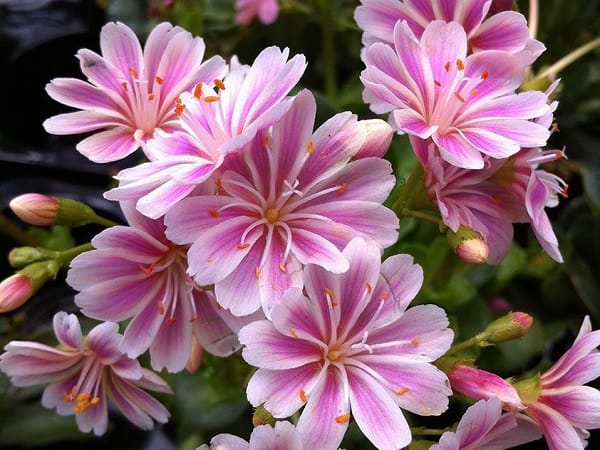

You will have a choice - there are many varieties of such a plant. There is Yellow with solid yellow flowers, Red Purple with deep pink flowers, snow-white Alba and many others. But the most popular is the Constellation with different shades of variegated flowers (the petals of each are lighter at the edges, and darker in the center) - this is the variety you see in the photo above.
Most varieties are hybrids.
Landing time and technology
Planting and caring for levisia should be carried out within strictly defined terms, which are selected based on the plant variety and the characteristics of the climatic zone.
When to plant Levisia
The time is chosen based on the method used for planting:
- When propagated by seed, they are sown directly into the ground from early September to mid-November or earlier. Before the onset of frost, at least 7-10 days must pass for the seeds to overwinter. In this case, sprouts will appear in April, which later gently dive to a permanent place or leave in the garden.
- If the seeds are planted in pots in spring, seedlings can be grown.
In any case, shoots are transferred to open ground only after the time when frosts are no longer expected. A plant from seedlings blooms only 2-3 years after the pick.
How to plant Levisia
Landing technique:
- select a site that is suitable for the degree of lighting and the level of groundwater;
- dig deep holes, cover about 50 cm of the bottom with rubble to organize drainage;
- Place the seedling vertically in the center of the hole, sprinkle it with earth;
- cover the root collars around with coarse gravel;
- you can mulch the ground with crushed stone or stone chips.
Germinating seeds
You can get started at the beginning of February... But at this time there is little light, and you will have to "strain" the phytolamp. If you do not plan to light up the seedlings, sow the seeds mid-March or early April.
- Fill a shallow plastic bowl with soil. I take a purchased flower one, it is not heavy and nutritious, but I put large pieces of foam at the bottom (most flower growers recommend making drainage holes in the bottom of the tray, but this is inconvenient). I immediately spill the soil with hot water (additional disinfection). When the soil has cooled, you can sow (but it is advisable to keep it still warm).
- The seeds are dusty, so you cannot deepen them, just sprinkle them over the ground. Even if each seed is covered with glaze and seems more or less impressive, you should not cover it with soil - the sprout from it will grow too weak, it will be extremely difficult for it to break out of the soil.
- If the tray has a transparent cover, great - cover it immediately. If not, use a bag or a piece of glass.
- Now you need to play with the seeds a little: keep them at room temperature for 10 days, in the refrigerator for 10 days (without removing the bag / lid, just wipe the condensate). Return the tray to the room.
- In a few days, you will see seedlings. This means that the seedlings need additional lighting. If spring is early, it is better to use a phytolamp, if in April, put the tray on the window.
Care features
Planting and caring for levisia in the open field requires regularity - watering when the soil dries out, treating insects and diseases, regular inspection, as well as fertilizing to improve the decorative effect and overall health of the flower.
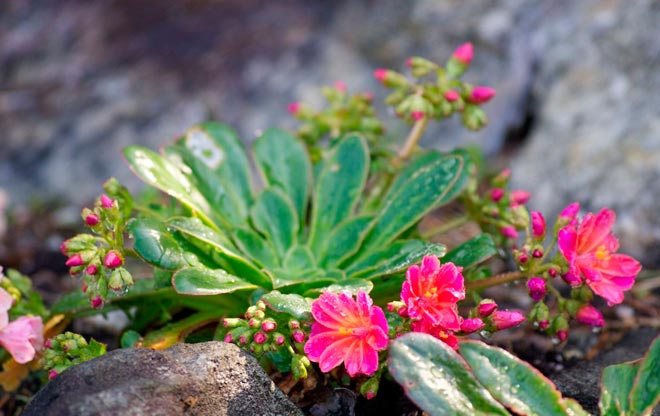

Watering and feeding
Watering is required in moderation, it is carried out only in the growing phase from the middle or early spring to the end of autumn.Care must be taken to ensure that there is no stagnation of moisture in the area of \ u200b \ u200bthe roots, which can lead to waterlogging of the earth and the death of plants. Water is applied strictly to the root zone; the jet must not be allowed to hit the center of the outlet and on the buds. In rainy weather, so that there is no excess moisture, the bushes can be covered with plastic or cut-off plastic bottles.
Top dressing is applied carefully, since an excess of nutrient components is stronger than their deficiency, causing deformation of the plant and a decrease in immunity. Add ready-made mineral mixes every 3 weeks. To make the plant look more lush and vibrant, alternate organic with mineral compositions.
Planting a flower in open ground
Levizia can be planted "free" in the central days of Maywhen she will no longer be threatened by night frosts.
Priming this mountain inhabitant needs loose, with excellent drainage properties. If you have clay soil in your garden, put some pebbles at the bottom of the planting hole, and dig up the earth in which Levisia will grow with a little sand.


Root collar do not deepen.
Important! The root collar is the weakest part of the plant. We have a lot of rains, because of them the "neck" of Levisia by the end of summer can touch rot. To prevent this from happening, immediately after planting, sprinkle the near-stem zone of the flower with fine gravel or quartz sand.
Yes, and the entire section of the flower bed or pots, where Levisia grows, costs mulch... But not with humus or sawdust, as we do with other flowers, but with sea pebbles. The main thing is to lay stones not too tightly to the ground, so that there are gaps between them.
If you have in your garden rockery, Levisia cotyledon is an ideal inhabitant for such a flower bed.
An interesting moment! The flower rosette is sensitive to water ingress... Of course, Levisia growing on the street will repeatedly get wet in the rains. But allow indoor-grown seedlings to get used to it gradually. Immediately after disembarking, place an umbrella over the levizia (yes, the most common one, or something like it). You will clean it up in a couple of weeks.
Plant care
- To water you need it wisely. If puddles begin to stagnate in the ground, Levisia will fall victim to rot, and if you arrange a "desert" for it, foliage will begin to crumble from the plant. You cannot water this flower during the day, do it only in the evening and in the morning. It is better to take water slightly warmed up and pour it only at the root, so that it does not fall into the outlet.
- This flower photophilous, but does not like overheating... Therefore, I would recommend dropping her in a place where the sun will shine on her in the morning, and after 12 days a shadow will fall.
- Reproduction... Each levisia does not live long, so when your bush forms children, do not throw them away, but plant them in a new place. You can also cut a leaf near the bush. It is better to root it in slightly damp sand.
Wintering garden levisia
Although this plant is American, it is still mountainous, so it is not afraid of cold weather.
In our country, Levisia can winter on its own, even no shelter... Although in central Russia it is still recommended to make a dry shelter for the flower or transplant it for the winter in a cool greenhouse.
But from lingering autumn rains it is better to hide the flower by erecting a "house" for each outlet from a large plastic bottle. In the side walls of this bottle, pre-form a "window" for the entrance of fresh air.
Required agrotechnical conditions
Growing levisia on the site will be simple if you know the basic agricultural techniques. A rock-type plant feels good on the eastern side of a hill of stones, does not tolerate bright light, so it is optimal to place it in the partial shade of boulders, bushes or trees. Stagnation of water, which leads to decay, is not allowed.
Climatic growth zones
Evergreen varieties practically do not tolerate winter, and not a drop in temperature, but more snow cover.During this period, it is necessary to make a dry coating or use other insulation in the form of caps. Deciduous levisiae do not require mulching and generally no pre-winter preparation.
Some varieties must be dug up and transferred to room conditions for the whole winter. If you leave them on the site, when the temperature drops below zero and abundant snow, the flower will die.
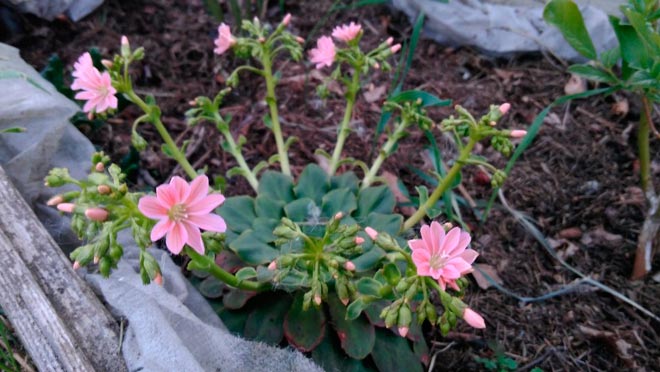

Location and lighting
Levisia will undoubtedly become the pearl of your garden. Original bright buds, similar to magnolia flowers, unpretentiousness to climatic conditions, simple reproduction - all this speaks in favor of the cultivation of this plant. But the flower does not feel equally well in all latitudes.
Lighting for him should be constant, but not intense. Place the flower on the east side, and in the presence of a bright sun, create partial shade.
In order not to shade the plants with improvised means, initially think over their location: it is required that the shadow falls from more massive plants, such as shrubs or trees.
Soil requirements
The soil for planting Levisia should be light, it is good to let air and water pass through during rains and watering. Good drainage is imperative. The flower prefers acidic soil, which can be enriched with peat, rubble, sand or humus can be added to increase the degree of aeration.
The root system of the plant is not too massive, therefore, when planting, it is enough to loosen and drain the upper 50-70 cm of the soil. Do not place the flower in places where groundwater is high.
Let's summarize
- There are about twenty types of levisia. But for growing from seeds, one is best suited - blunt-leaved levisia (cotyledon).
- The seeds of the plant are very small, they cannot be deepened into the ground. Seedlings do not like picks, therefore, if it is worth transferring it to a new place, then only once - on 10-14 days of life.
- Seeds are sown from late February to mid-April. Seedlings can be transferred to the garden from mid-May.
- When leaving, the main thing is not to allow the transfusion of the flower, otherwise its root collar will begin to rot. In the fall, when the rains become more frequent, Levisia can even be covered with an inverted plastic bottle. But the flower can winter without shelter.
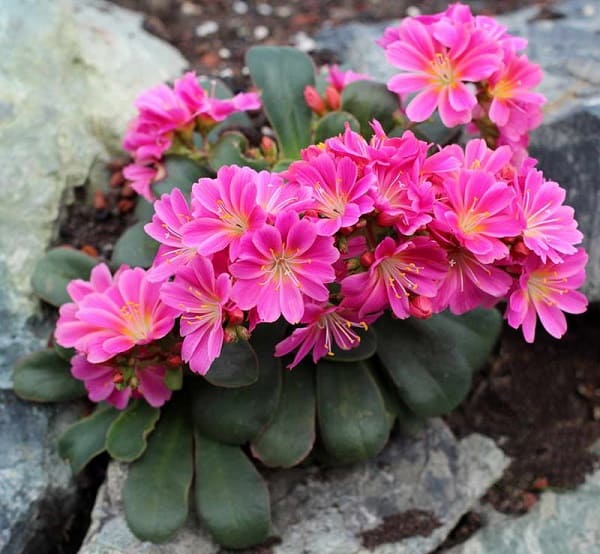

In this video, you will learn about a private winter planting experience in which the seeds of Levisia and other crops are stratified outside. The video is not professional, so the picture is not entirely perfect, but it will allow you to see if the seeds have sprouted in such conditions, and hear about the experience that the grower received:
1.Levision - landing and leaving
1.1 Reproduction - growing from seeds
By dividing large plants when transplanting or sowing seeds in the spring.
1.2 Home Leasing
During the flowering period, the leaves of Levisia can dry out and fall off - this is normal.
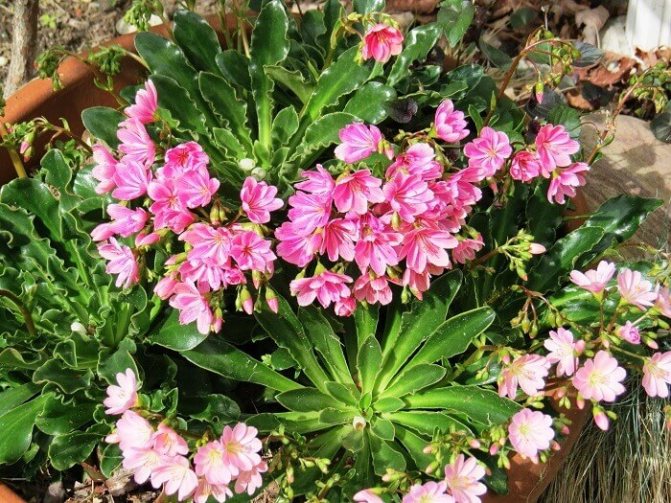

1.3 When it blooms
The flowering time is towards the end of spring - summer.
1.4 Containment Temperature
Moderately warm during the growing season at a temperature of about 20 ° C. During the winter months, Levisia provide a cool dormant period at a temperature of about 12 ° C.
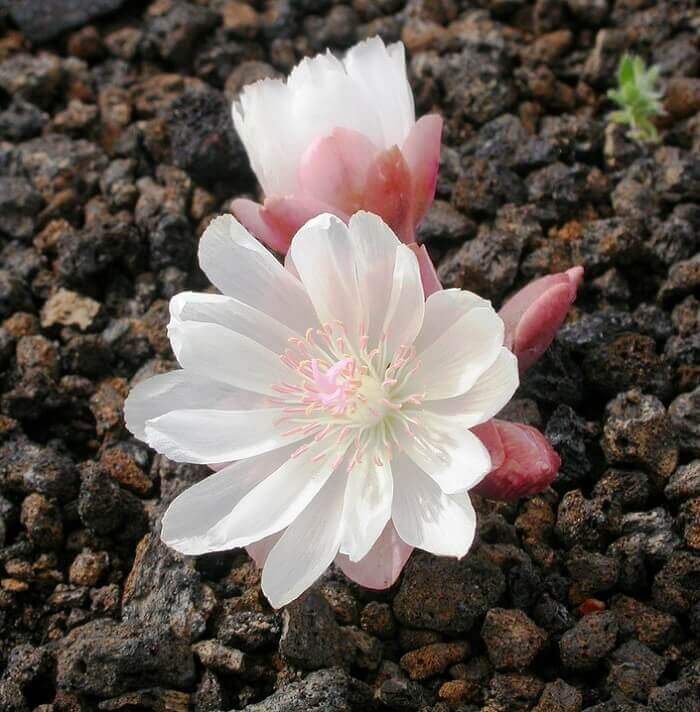

1.5 Lighting
Brightly lit location with no direct sunlight.
1.6 Soil
Well-drained soil with the addition of 50% coarse river sand. The root collar of the plant can be surrounded by a layer of coarse sand or fine gravel for better moisture drainage. Ready-made mixtures for succulent plants are suitable.
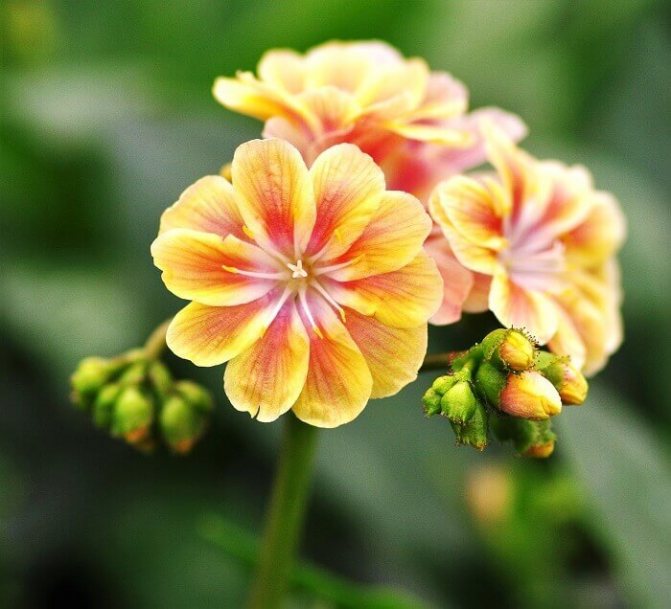

1.7 Fertilizer
During the period of active growth, feed Levisia every 2 weeks with liquid fertilizers at half the concentration.
1.8 Spraying
Does not need spraying. In autumn and winter, the air must be dry. Prefers ventilated rooms with constant air movement.
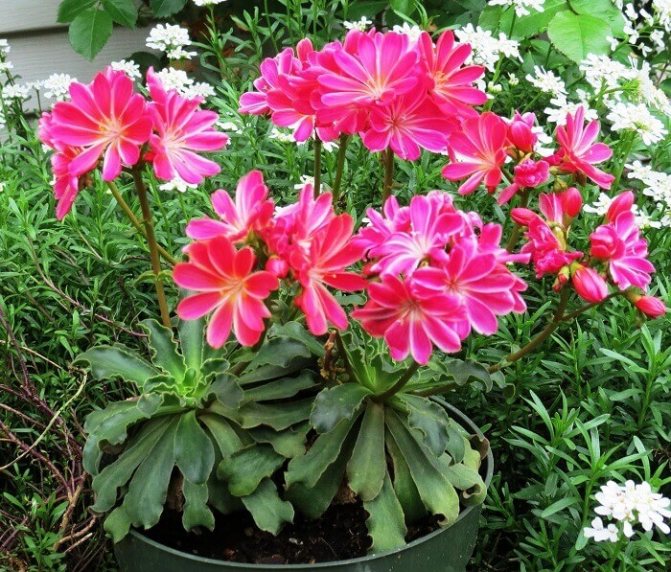

1.9 Watering Levisia
Water Levisia so that the soil has time to dry at least half the depth before the next watering. In the winter months, the soil simply doesn't have to dry out completely.
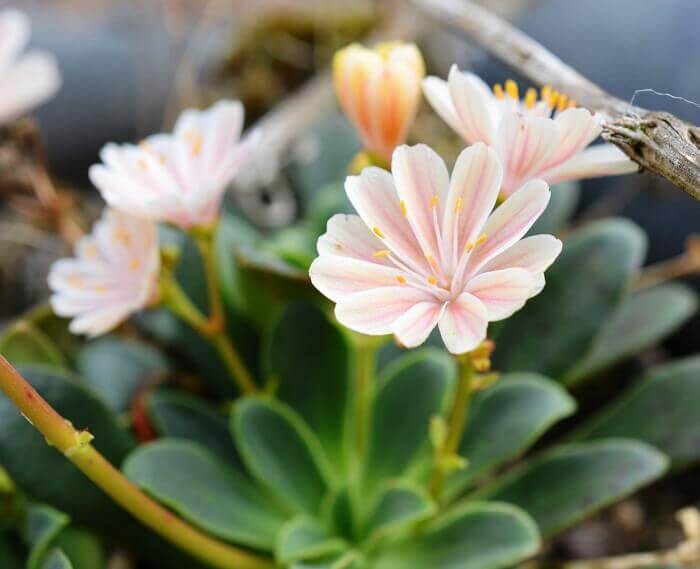

1.10 Transfer
Adult plants are transplanted in spring, when new growth begins, every 2 to 3 years. When transplanting, levizia is planted at the same depth at which it was previously.
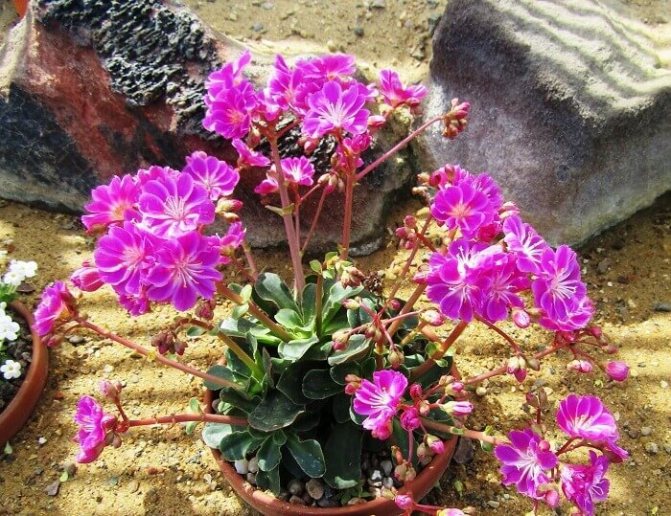

1.11 Pests and diseases
Levisia easily rots when waterlogged.
1.12 Purpose
Valuable decorative flowering plant. Looks perfect in rock gardens. Plant 2 - 3 levisions in one pot.
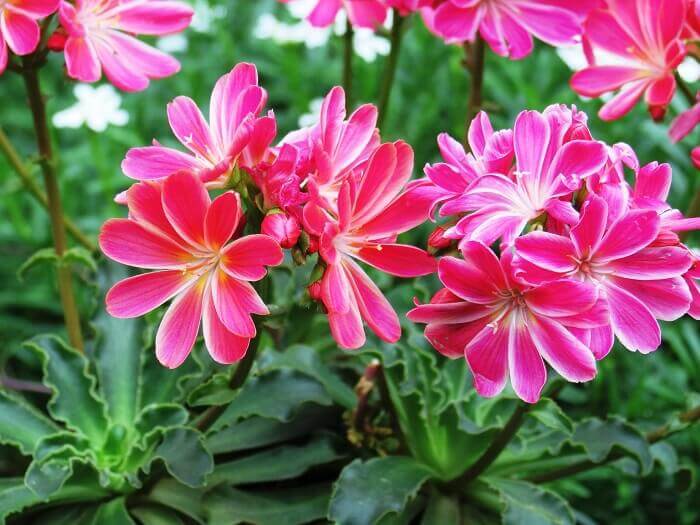

Note.
Hydroponics .
Growing
The ability of the Levizia to winter in the conditions of central Russia depends on the type, soil properties and microclimate of the site. Stably winters and gives abundant self-seeding on different types of soils L. pygmaea. L. nevadensis is slightly more capricious. The aristocratic L. cotyledon in Russia survives only on acidic sandy soils, poor in minerals, in bright sunlight and does not grow on loams. The rest of the species have been insufficiently tested. Plant in well-drained soil in the spring.
In the greenhouse, deciduous species are watered, greatly reducing watering in late autumn and winter. Evergreen forms are watered throughout the year, limiting watering in summer. It is useful to sprinkle the root collar with gravel to prevent it from getting wet. During the growth period, regular fertilizing with mineral fertilizers is needed.
Variety of species
The genus of Levisia has more than twenty species. People grow mainly hybrids that have massive flowering. The plant is divided into evergreen and deciduous varieties. Their cultivation is different. When choosing a Levisia variety for yourself, focus on plant hybrids that will best suit you for the climatic conditions.
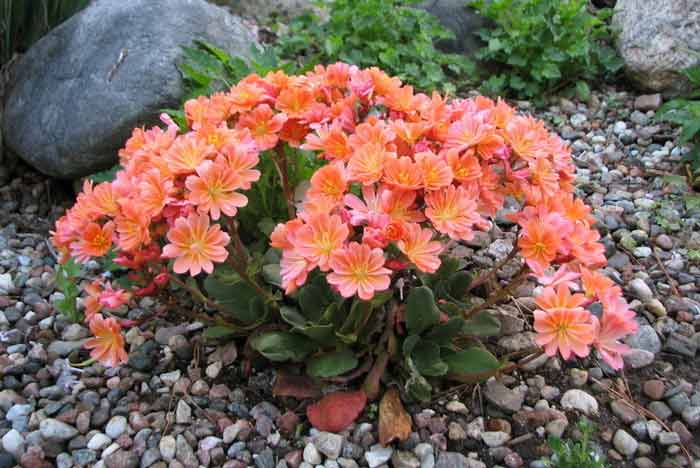

Levisia
The most popular types of levisia, which have the greatest decorative effect, will be:
- Levisia cotyledon. One of the common species that is easy to grow. Many hybrids have been created on its basis. This perennial has 15 centimeters long leaves, along the wavy edges of which there is a red border. The shape of the rosette and its density depends on different conditions. The bloom is bright. It begins in May and occurs in the form of the appearance of a volumetric inflorescence, with flowers on it, which have up to 15 petals. Shades can mutate if the plant is propagated by seed. They are: orange, red, yellow, pink and white.
- Levisia is long-petaled. Among the belt-like leaves are 10 centimeters thin petioles. On them there are four-centimeter buds in the form of pink water lilies. Flowering occurs in June.
- Levisia is short-peeled. It has a deciduous crown, with long leaves about 10 centimeters long. A bluish bloom is formed on them. Flowering occurs throughout the spring, in the summer there is a dormant period, and the crown begins to grow actively in the fall. The shade of the buds from white in the middle gradually turns into pink towards the edge. It varies based on the conditions of the plant.
- Pygmy levisia. A dwarf species that produces a rosette of long leaves up to 10 centimeters in late spring. Seven white buds are collected in an inflorescence. They bend over to the ground. In summer, the plant disappears, and in autumn it forms its foliage again.
- Colombian levisia. This variety has a small rosette with reed foliage. From the middle of the bush, a thin peduncle appears with white - pink buds, streaked with veins of a bright shade. Flowering takes place all summer.
- Levisia Tweedy. The species was named "flowering cabbage". He is the most spectacular. Among the bright rosette of leaves are flowers of unusual shades, which are blurred around the edges. The colors often hybridize. With the onset of cold weather, it must be dug up and placed in a greenhouse.
- Levisia sierra. View with large grayish leaves serrated along the edges. The buds are five-petal, white and pink. They have streaks of dark pink color. They resemble a lily in appearance. Flowering occurs from May to mid-summer. The plant itself is small, no more than six centimeters.
- Levisia Nevada. It has a curved shape with fleshy leaves. The flowers are white with greenish stamens. They open only on days with bright sun. Their bloom lasts from May to autumn. It multiplies quickly with the help of children.
- Levisia Congdon. The species is considered valuable and rare. Peduncles are high. They hold inflorescences with buds of pastel shades and darkish veins. The plant grows up to half a meter. It blooms from spring to mid-summer, sometimes flowering can occur again in autumn.
We select soils for levisia
It is much easier to pick up the soil for levisia. This plant needs the highest quality garden soil - loose, well-drained and fertile. Particular attention should be paid to acidity: Levisia prefer to grow only in acidic soils. An admixture of not only peat, but also crushed stone, sand, humus, and preferably cow dung, is mandatory. But there is only one critical parameter - drainage.
Levisia in containers also need to select high-quality soil mixtures. Usually they use universal substrates, consisting of garden soil with the addition of sand and compost. But if the soil is suitable for almost any of the high-quality ones, then the containers need to be given increased attention.
Levisia will bloom colorfully only in small containers and pots, because an excess of free soil can cause active vegetation to the detriment of flowering. Please note that it is better to plant this perennial in a container with several drainage holes. And at the bottom it is imperative to lay a powerful drainage layer.
Conditions comfortable for levisia
Finding the perfect site for levision is not easy. They wonderfully combine tenderness and love of the sun. They must be planted in sunny areas, but with light shading at noon and the hottest lunch hours, with diffused light. And Levitin cannot stand the gifts, preferring moisture and coolness.
It is not easy to fulfill these requirements, but it is possible: the plant is combined with a higher partner (or placed near a boulder, wall, elevation), which will create an openwork shadow in the middle of the day and prevent the soil from overheating intensely. But at the same time, the place should still remain well lit. Before landing, be sure to observe the movement of the sun and evaluate the change in light regime from morning to late evening.
The process of selecting lighting, comfortable levisia is in many ways similar to the selection of conditions for indoor plants: this baby will feel good on the eastern and western slopes, in places with an eastern orientation. It is considered a win-win to place the levisia between two boulders, in a kind of crevices with a thick layer of drainage laid.
Potted Levisia need the brightest, but diffused lighting: these beauties are afraid of direct sunlight. Outdoor terraces, balconies or seating areas, potted Levisia hybrid varieties will bloom colorfully even in partial shade.
This plant is not the most heat-resistant perennial. During extremely hot days, levisia can stop developing (which does not mean a complete stop of flowering, because it can continue after a rapid recovery of comfortable temperatures).
In Levisia growing in open soil, this phenomenon is rarely observed, only when the plant receives practically no care, but in potted Levisia it is quite typical. Species levizia, after flowering or in dryness, can completely go into dormancy, without even leaving leaves. The disappearance of the rosettes does not indicate the death of the plant.
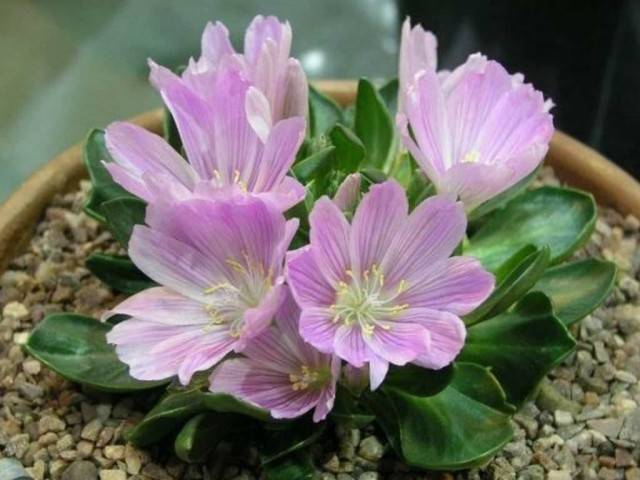

Levisia short-peel (Lewisia brachycalyx).
Plant maintenance problems
Levisia flowers are a favorite delicacy of slugs. If there is diseased flower bushes nearby, then the plant may suffer from aphids. Pests are fought with insecticides.
Waterlogging of levisia can cause rot disease.They cope with it with the help of correction of care and treatment with fungicides.
Evergreen plant species do not tolerate winter wetness, so for this period they are covered with caps or a dry shelter is made. Deciduous species do without mulching in winter and require no preparation for winter. If you purchased species in which the instructions say that they need digging for the winter, then strictly adhere to the requirements, otherwise the plant will die.
Potted Levisia needs, as winter approaches, a cool room that is well lit and does not freeze.
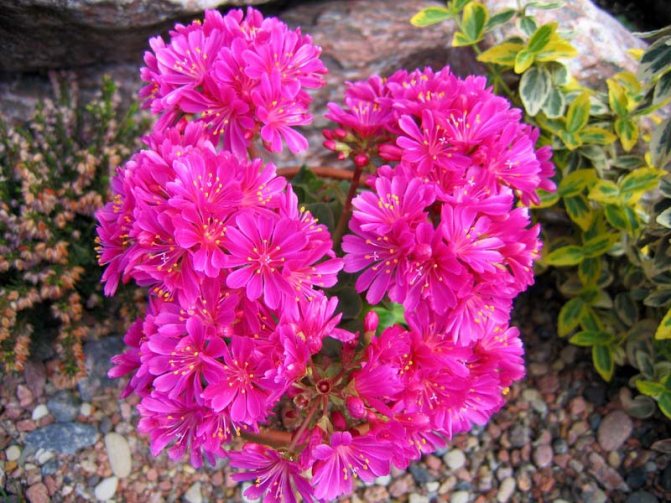

How to protect levisia from diseases and pests when caring for the garden?
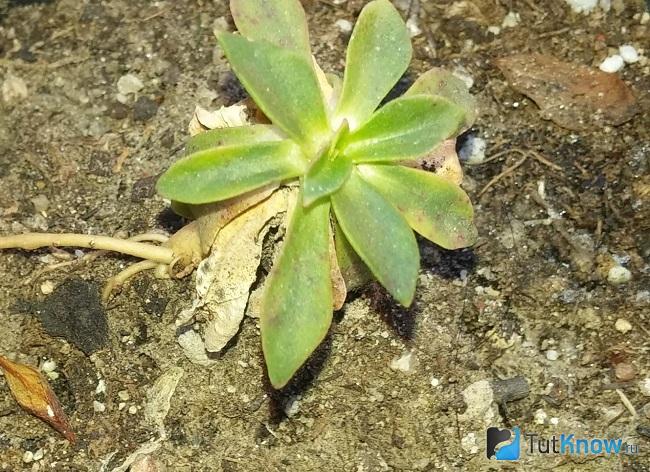

If the growing conditions are not violated, then the plant shows an excellent result of resistance to diseases and pests. Most often, when the soil is flooded, in humid and warm weather, levizia can be affected by various types of rot. Then the leaf plates become soft to the touch, lose their turgor and their surface is covered with brown spots. To prevent the death of the succulent, it is recommended to dry the soil and not disturb the watering regime. In more difficult cases, the plant is removed from the soil, the damaged parts are removed, and the sections are sprinkled with crushed coal and then treated with a fungicidal preparation, for example, Fundazol. Then the bushes are planted in a new place, but there is no guarantee that they will be able to survive such manipulations.
Of the pests that like to attack the succulent leaves of Levisia, aphids and slugs are emitted. Against insects, insecticidal agents, such as Aktara or Fitoverm, should be used, metaldehyde (for example, Meta-Groza) is recommended for gastropods, or they should be collected by hand.
Curious notes about the Levisia flower
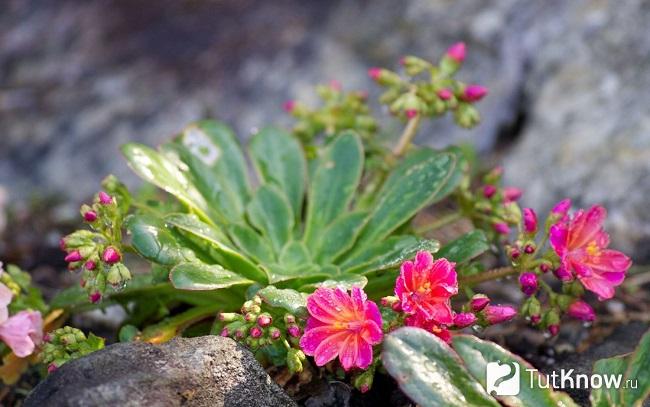

Another version of the origin of the name of the plant is that it bears the name in honor of the researcher who studied the nature of North America - Merivetra Levi. This prominent scientist was the official representative of Great Britain in America, where he dealt with problems related to jurisprudence. But in addition to this honorable mission, Levy enthusiastically studied questions of botany and research in the field of flora of the North American lands.
Levisia of only a few species were brought to the territory of Europe, where they quickly won the love of amateur flower growers, especially those who were engaged in landscaping rockeries and rock gardens.
Landing levisia
No matter how good the soil is, planting a levisia is a very specific process. For this, plants dig deep planting holes, at the bottom of which drainage is laid with a height of about half a meter. Only under such conditions will Levisia be able to grow on a flower garden or in a front garden. But the specificity of the landing of Levisia is not limited to the laying of drainage.
After installing the seedling and carefully filling the planting hole with soil, the root collars will need to be carefully overlaid with gravel, and the soil should be mulched with crushed stone, gravel or stone chips, which will reliably protect sensitive American women from waterlogging.
Watering Levisia
It is recommended to water the plant only when it is really needed - in the heat and during growth. It is important to prevent the ingress and formation of stagnation of water on foliage and buds, resulting from waterlogging of the soil.
Watering is done very carefully, ensuring that water is drained from the foliage. Also, the leaves should not be allowed to come into contact with the moist soil surface, and in an area with frequent natural precipitation and in the case of growing among other plants that need abundant watering, an inclined surface should be organized.
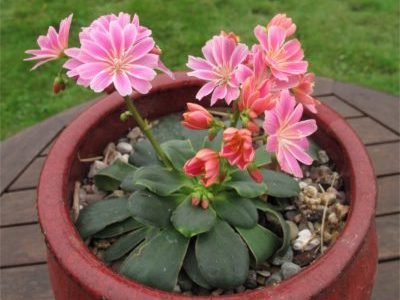

1. Seven Secrets of Success:
| 1. Growing temperature: during the growing season and flowering, the content is quite warm at a temperature of about 20 ° C, in winter the flower is left in a cool place at a temperature of about 12 ° C. |
| 2. Lighting: it is necessary to shade from direct rays of the sun in spring and summer during the daytime, in autumn and winter maximum light. |
| 3. Watering and humidity: the plant is watered abundantly, but rarely. Even in spring and summer, the substrate is dried almost half the depth. In the winter month, watering is minimized, protecting the soil from completely drying out. It tolerates the rather dry air of living rooms and does not need spraying. |
| 4. Features of the: in some varieties of levisia, leaves may fall off after flowering - this is normal. |
| 5. Priming: Possibly nutrient-poor, but loose, well-drained. |
| 6. Top dressing: in spring and summer, when levisia is actively growing, it is fed with mineral fertilizers every 2 weeks. After flowering, another 1 - 2 dressing is carried out and then fertilization is stopped until the start of new growth in spring. |
| 7. Reproduction: by dividing large plants when replanting or sowing seeds in spring. |
Botanical name: Lewisia.
Family... Montievs.
Origin... North America.
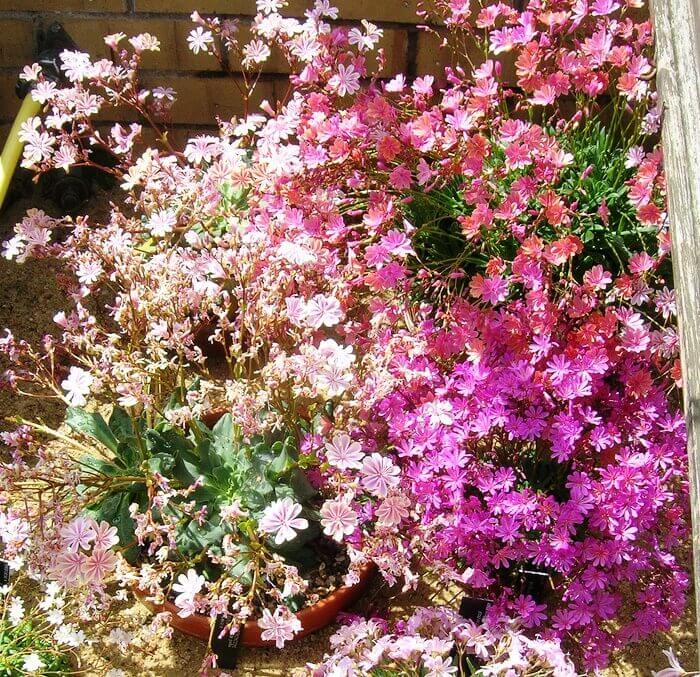

Description. Levisia - one of the brightest flowering herbaceous plants. Fleshy, rounded or oblong-lanceolate waxy leaves form a symmetrical basal rosette. Peduncles are leafless, high at the top of 5 - 6 charming flowers up to 5 cm in diameter in bright pink, apricot, white, yellow or red colors. There are varieties with flowers in two different shades.
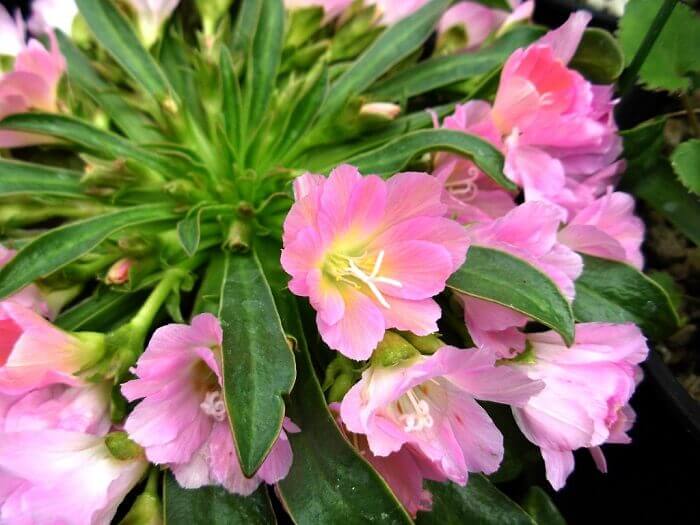

Height... Levisia reaches 10 - 15 cm in height.
Lighting requirements
Growing levisia requires some knowledge. Caring for her is not so easy, since the plant is capricious. Levisia loves a sunny place, but with a little shading and scattering of bright light during the hottest time.
Therefore, it is planted near higher flowers or near walls, stones.
The best thing
plant it on the eastern or western slopes.
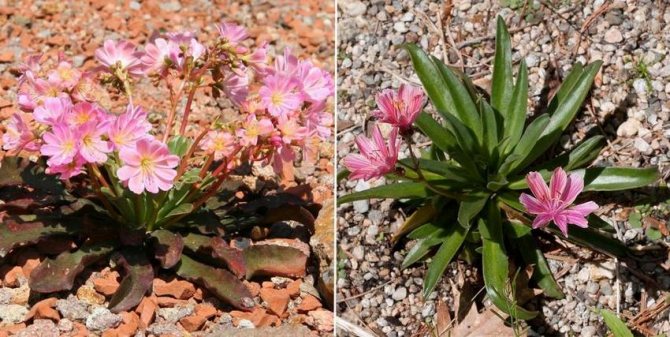

It is good to plant it between two boulders. But it is necessary to provide the plant with good drainage.
Levisiae that grow in pots need a bright place, but with diffused lighting. For example, on a terrace, loggia, balcony.
Main varieties
The genus Levisia has more than 20 varieties, which, in turn, are divided into deciduous and evergreen species and varieties.
The most common are the following:
- "Magic of Fuchsia". An amazingly beautiful plant, thanks to the bright color of a rich pink-purple color;
- Pinky. This variety with original pale pink flowers tolerates dampness well;
- Ash Pearl. Blossoming - abundant, color of flowers - pearl white;
- Roy Elliott. The flowering period is about 3 months, the color of the flowers is dazzling white;
- "Matthew". This variety is distinguished by the large size of the leaf rosette, orange flowers;
- Sunset Strain. Bright orange variety;
- "Norma Jeane"... Plants of this variety form many rosettes and hundreds of pastel pink flowers;
- George Henley. Original bushes with fuchsia-colored flowers, under which the rosettes are not visible;
- Beautiful looking in terracotta pots Levisia with a sunny, melon-apricot color.
Growing levisia in the garden
Levisia is a succulent plant with amazing large star-shaped flowers that will impress any gardener. A perennial plant belongs to the Purslane family. In nature, it grows in the arid regions of the western coast of North America, some varieties can be found in the crevices of the rocks of Canada and Mexico.
Growing Levisia in the garden is not particularly difficult. Subject to some care rules, this amazingly beautiful plant will become a real decoration of your garden.
The height of the perennial is only 20-30 cm, the root is strong and thick with a small nodule. Due to the long length of the root system, the succulent is difficult to transplant, since, digging up the bush, the roots can be damaged.
Leaves are leathery, evergreen or deciduous, sometimes corrugated at the edges, forming a basal flat rosette with a diameter of 20-30 cm, resembling a starfish in shape.
In the spring, the plant throws out peduncles covered with buds of all shades of pink, white, yellow, lilac, red or orange. Abundant flowering occurs in May-June.
Landing levisia
The choice of the place of growth of the plant is very responsible. Levisia loves the sun, but in the daytime she needs shading with diffused light. She prefers moist soil and coolness. In this connection, it is better to keep it near boulders and walls, which will provide shade in the heat and prevent the soil from overheating. It is important to watch how the sun moves during the day before planting. If you place the levizia between the boulders, then this will be a win-win option.
Potted Levisia should not be left in direct sunlight. Even in partial shade on balconies and terraces, they bloom well. As mentioned above, the plant does not tolerate heat well and may stop developing.
When you start to select the soil for levizia, you should remember that it must be well-drained, and also enriched with useful organic matter. The plant prefers an acidic environment with the obligatory addition of peat, sand, gravel and humus.
For planting in a pot, you can use a universal soil with the addition of sand, as well as compost. You should not choose a volumetric container, as it will negatively affect flowering. The bottom is laid with a good drainage layer. It is advisable if the pot will have multiple drainage holes. When planting a plant in the ground, it is necessary to overlay the root collar with gravel at the end and mulch everything around it.
Levisia in winter
Hybrid varieties of Levisia, like all representatives of this genus, are thermophilic. In temperate and subtropical climates, the Levisia have a hard time enduring the winter. Therefore, in order to preserve the shrub, you should carefully prepare it for winter and insulate it.
In order to protect the roots from freezing before the onset of frost, a dense layer of dry leaves or spruce branches, straw is laid on the shrub. It is also possible to cover the plant with a special material. After that, the bush is covered over with plastic or glass containers in order to avoid waterlogging of the soil in the spring.
Levisia care secrets
In order to enjoy the luxurious flowering of Levisia, it needs to provide more or less stable growing conditions. It is not difficult to take care of this plant, but Levisia will have to pay attention at the flowering stage.
This culture needs watering, but only rare and responsive to the vagaries of the weather. Levisia is watered during a drought so that the plant does not stay too long in completely dry soil. The procedures should be moderate and very careful: when watering, it should not be allowed that moisture gets not only on the buds and flowers, but also on the leaves of the Levisia.
Potted Levisia is watered so that the substrate always remains slightly moist, but the soil dries out between treatments in the middle layer. If levisia growing in pots has a stop in growth, a pause caused by heat, then watering must be stopped, but the plant must be constantly sprayed until development resumes.
Top dressing is the most important component of care. It is from the correctly applied fertilizers that both the beauty and the duration of the flowering of Levisia will depend. But, fortunately, fertilizing for this crop is not at all similar to the fertilization system for the summer. Levizia is fed only in the summer, with a frequency of 1 time per month applying fertilizers to the soil.
At the same time, do not rush to use mineral mixtures: Levisia loves organic fertilizing more, in particular, fermented manure diluted in water. Even if you have the time and opportunity, you should not feed Levisia more often than 3 times a summer. When overfeeding, it will not bloom more luxuriantly, but it will start to hurt, the process of laying the buds and winter hardiness will suffer.
Levisias are so beautiful that even slugs cannot resist them. These pests love to feast on not so much the leaves as the flowers of the plant.In the vicinity of diseased shrubs, levizia can also suffer from aphids, but in general it is a fairly persistent crop. It is necessary to deal with problems, including rot caused by waterlogging, using combined methods, correcting misses with care and spraying the bushes with insecticides and fungicides.
Preparation for wintering is needed exclusively for evergreen levisia. These beauties will not endure getting wet in any form in winter, therefore, before winter, they are covered with caps (usually glass) or create a dry shelter. Deciduous levisiae hibernate even without mulching. And the rest of the plant does not need any preparation for frost and snow. If you buy a rare or species Levisia and have received recommendations for digging for the winter to protect it from getting wet, strictly follow the instructions.
But potted plants will need a different approach: as the first frost approaches, they should be moved to a cool, but frost-free room with good lighting. Depending on how much the earthen lump is filled with roots, the plant can be transplanted before carrying or wait with the procedure until spring. The earthen lump for levisia is preserved completely, without destroying, transferring the plant into a container of slightly larger diameter.
Reproduction of levisia
This magnificent plant reproduces well, even if it takes some effort to get a new generation of Levisia. Levizia seeds must be sown immediately after harvesting, because they lose their germination literally in geometric progression. There are 4 methods of breeding levisia:
- Sowing seeds in open ground... It is carried out before winter, on the rational ridges, mulching the soil from above with a thick layer of peat or compost. Seeds will germinate only by April, while they can both be dived, acting very carefully, and not be touched for strengthening throughout the year, and only then planted in a permanent place. After a month of stratification, sowing can also be carried out in the spring, but in this case it is better to sow levizia seeds on seedlings, and not into the soil.
- Sowing seeds for seedlings... They will germinate after a month of stratification in cold but not frosty conditions. In this case, stratification must be carried out after sowing. Seeds are sown in a moist and loose substrate, slightly covering with soil and tightening with a film or covering with glass. In a refrigerator or other place with a temperature of 0 to 5 degrees, Levisia is kept for a month, after which the containers with crops are moved to a warm and bright place. Plants should not be touched until the second true leaf is released, after which it is necessary not to delay the stripping. Seedlings can be transferred to open soil after the threat of recurrent frosts and nighttime cold snaps disappears. Such levisia will bloom only for 2-3 years.
- Cuttings, or rather the separation of lateral plants. Levisiae in a healthy state and after several years of lush bloom begin to form lateral rosettes. They do not have their own roots and the process of planting is similar to grafting. The sockets must be carefully cut off with a sharp knife, trying not to harm the shoots of the main bush. After separation, the sections are sprinkled with coal, dried, and the cuttings are planted in pots or containers with a loose substrate. Containers should be placed in a cool place and kept lightly humid. In the soil or in a permanent pot and the usual conditions, cuttings of levizia can be transferred only after high-quality rooting and the beginning of active growth. Spring is considered the best time for separation of children.
- Self-seeding use as a source of quality seedlings.
As an alternative method, the root dissection method is rarely used (in early spring, notches are made at the top of the rhizomes, which stimulate the formation of new growth points), but for countries with severe winters, this method is quite risky.

